WES HALL, U OF T’S 35TH CHANCELLOR
Diving into Hall’s life from growing up in the Caribbean to having a successful career in Canada
Medha Barath Business & Labour Editor
On July 1, 2024, Canadian businessman and philanthropist Wes Hall began his three-year term as U of T’s new Chancellor. The Chancellor serves as the university’s ambassador locally, provincially, nationally, and internationally and also chairs U of T’s Convocation.
Hall has had a storied career — he worked as a law clerk, founded his own private equity firm, and served as a judge on Dragons’ Den, the show where entrepreneurs pitch their ideas to Canadian
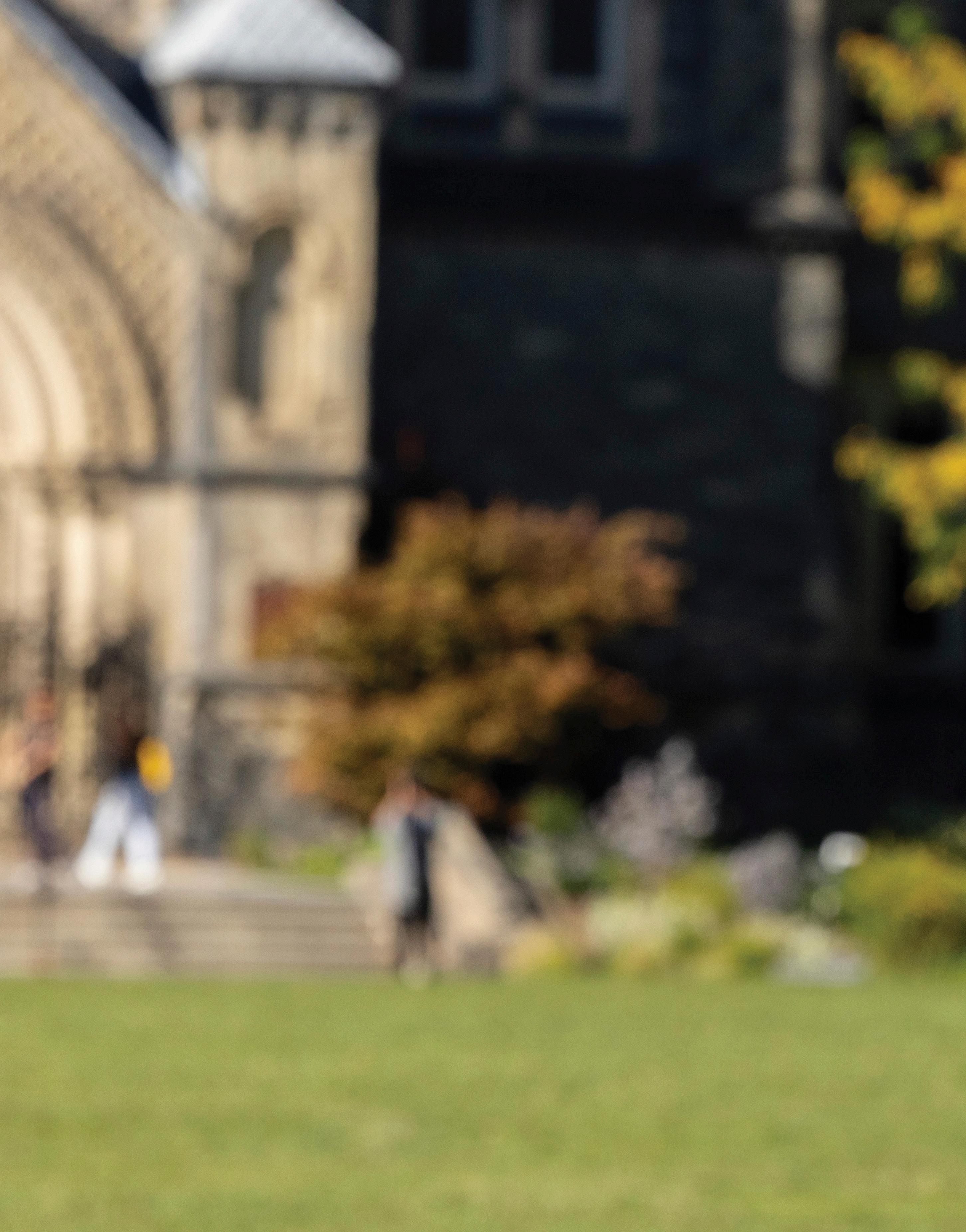
who lived in Canada, eventually decided to bring his son here. Hall recalls his anxiety surrounding the move: “I thought something was going to prevent me from going… I don’t know what it was, but I can’t be this lucky.” Hall eventually arrived in Canada with no issues — “I got through and… there’s my dad… this is the dream I had.”
Coming to Canada was a culture shock for Hall. “I got in this car and then I [started] to drive on the 401. I’d never seen a highway like that before.” It was also Hall’s first time experiencing fall and winter, which he found beautiful, “it was a pleasant culture shock.”
recalls competing against more experienced candidates, but emphasizes that confidence played a key role in helping him secure the job.
With his experience, Hall founded Kingsdale Advisors, a strategic shareholder advisory firm. These firms provide companies with guidance on shareholder activism — when shareholders use their stakes to influence management — and corporate governance. His business was initially met with skepticism. “I went to all the banks to sell them on the idea, and they thought I was crazy,” he said
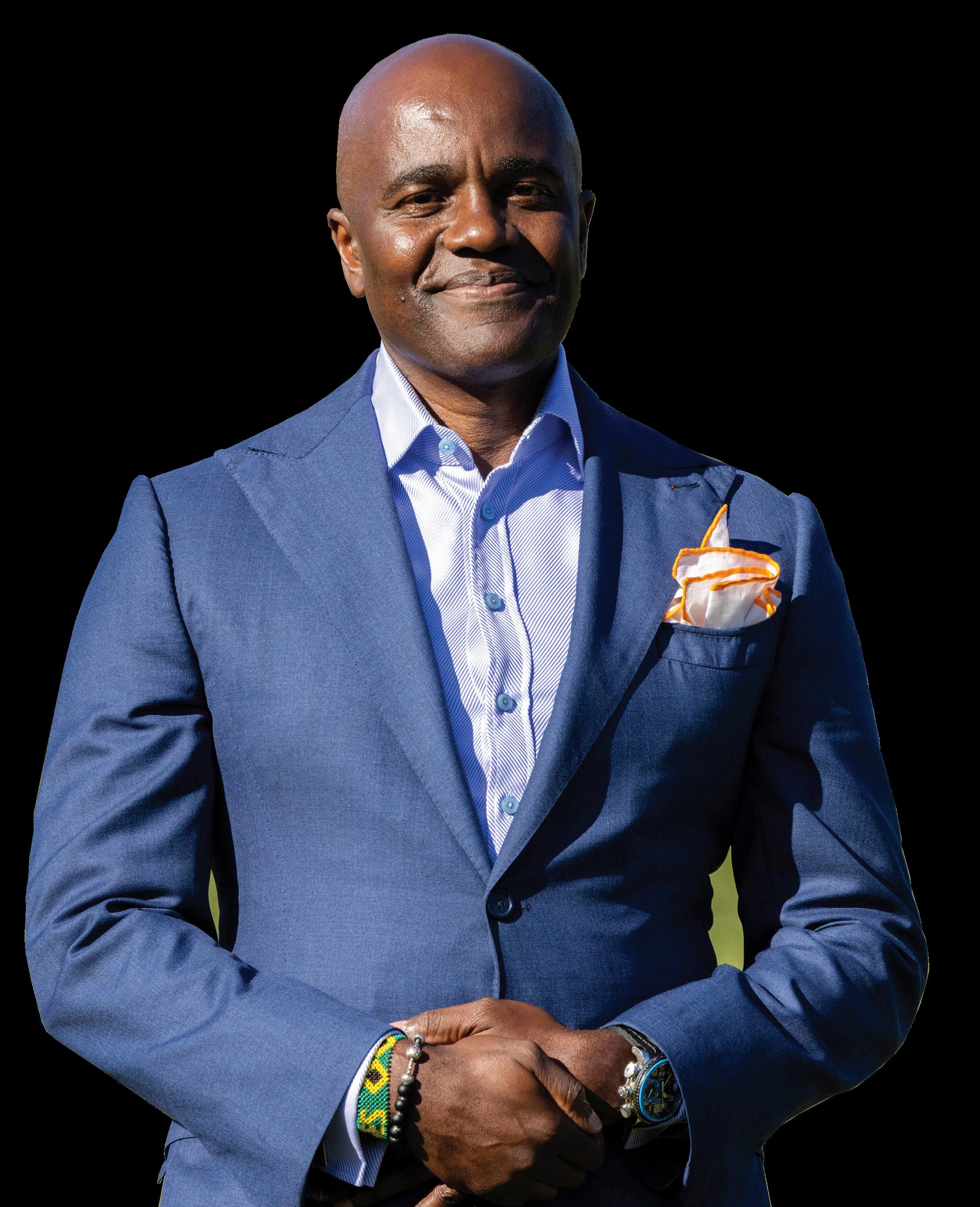
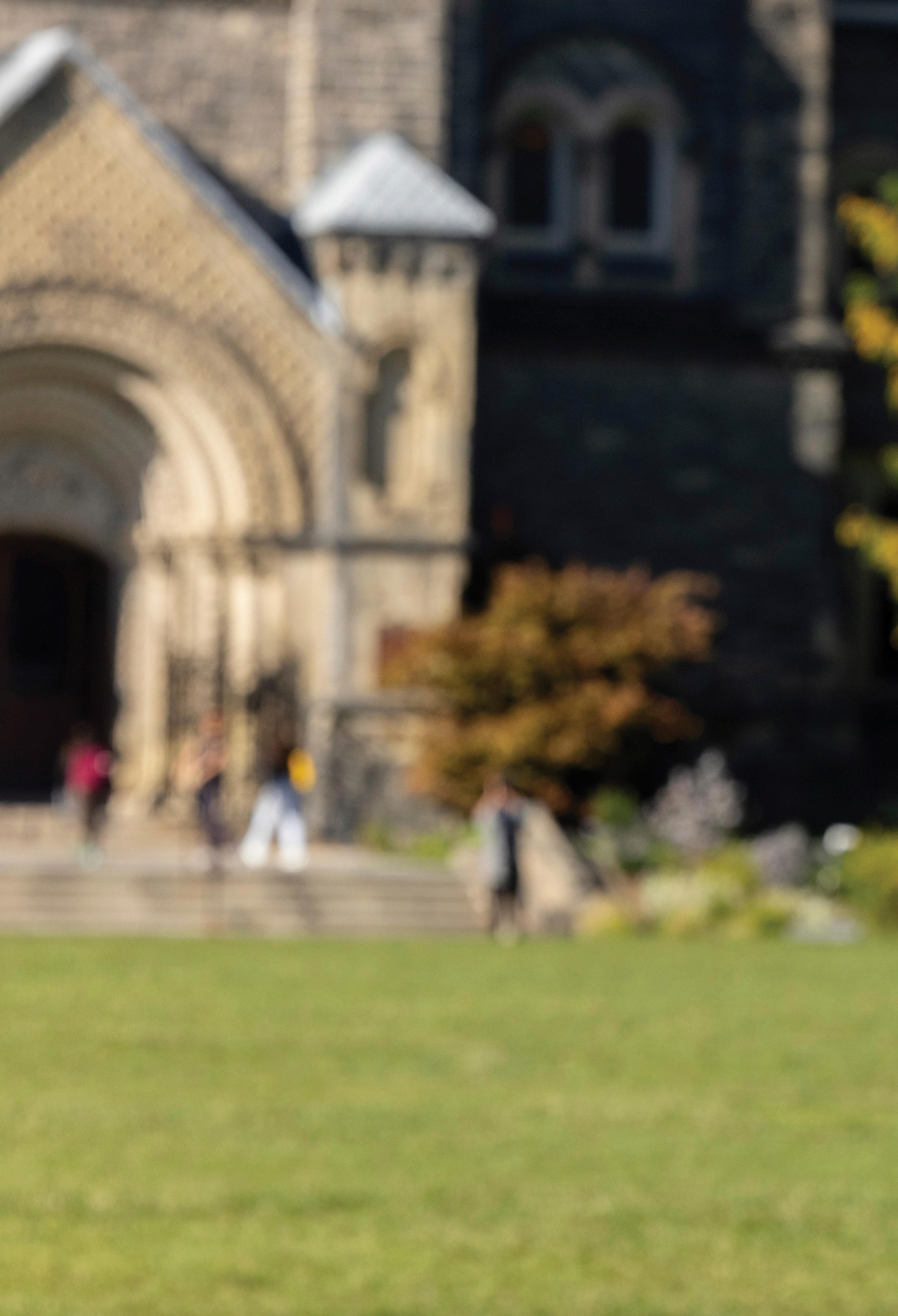
After consulting his wife, Hall mortgaged his house and officially launched Kingsdale Advisors, which is now considered one of Canada’s top advisory firms.
Black entrepreneurship and leadership at Rotman Hall has been deeply committed to improving diversity in the business community. Before 2020, a member of the UTSC campus approached him to create a new program, noting “students would benefit from [Hall]’s
Although he initially did not have time to dedicate to the initiative, the onset of COVID-19 allowed him to focus on developing the Black Entrepreneurship and Leadership course at the Rotman School of Management. The syllabus included case studies of successful Black entrepreneurs such as Madam C.J. Walker and Michael Lee-Chin.
The course also explored the experience of immigrants and non-Black persons of colour. Hall explained that he wanted to “focus on people who came to [Canada] and built something of themselves.”
The program was eventually offered online in the Spring 2021 semester. Hall recalls that students greatly enjoyed the course, and he valued the experience himself: “It was a privilege for me to be a part of that.” As the course continues, he hopes to eventually offer an in-person edition.
Continues on page 5.

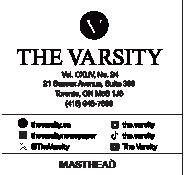
T HE VA RSI T Y
21 Sussex Avenue, Suite 306 Toronto, ON M5S 1J6 (416) 946-7600
thevarsity.ca
thevarsitynewspaper @TheVarsity
Vol. CXLVI, No. 5 MASTHEAD

thevarsitypublications the.varsity The Varsity
Medha Surajpal editor@thevarsity.ca
Editor-in-Chief
Chloe Weston creative@thevarsity.ca
Creative Director
Sophie Esther Ramsey managingexternal@thevarsity.ca
Managing Editor, External
Ozair Chaudhry managinginternal@thevarsity.ca
Managing Editor, Internal
Jake Takeuchi online@thevarsity.ca
Managing Online Editor
Nora Zolfaghari copy@thevarsity.ca
Senior Copy Editor
Callie Zhang deputysce@thevarsity.ca
Deputy Senior Copy Editor
Ella MacCormack news@thevarsity.ca
News Editor
Junia Alsinawi deputynews@thevarsity.ca
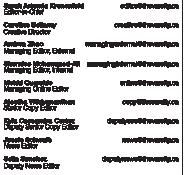
Deputy News Editor
Emma Dobrovnik assistantnews@thevarsity.ca
Assistant News Editor
Ahmed Hawamdeh opinion@thevarsity.ca
Opinion Editor
Medha Barath biz@thevarsity.ca
Business & Labour Editor
Shontia Sanders features@thevarsity.ca
Features Editor
Sofia Moniz arts@thevarsity.ca
Arts & Culture Editor
Ridhi Balani science@thevarsity.ca
Science Editor
Caroline Ho sports@thevarsity.ca
Sports Editor
Aksaamai Ormonbekova design@thevarsity.ca
Design Editor
Brennan Karunaratne design@thevarsity.ca
The Varsity acknowledges that our office is built on the traditional territory of several First Nations, including the Huron-Wendat, the Petun First Nations, the Seneca, and most recently, the Mississaugas of the Credit. Journalists have historically harmed Indigenous communities by overlooking their stories, contributing to stereotypes, and telling their stories without their input. Therefore, we make this acknowledgement as a starting point for our responsibility to tell those stories more accurately, critically, and in accordance with the wishes of Indigenous Peoples.
“People can’t survive on that,” students respond to New College meal plan
New
All-You-Care-To-Eat
model limits dining hall visits for cheaper tiers of meal plan
Emma Dobrovnik, Junia Alsinawi Assistant News Editor, Deputy News Editor
This year, students living in New College residence are paying more for meal plans but receiving less, following the introduction of the new Access Plan, which uses an All-You-Care-To-Eat (AYCTE) model.
The Access Plan offers three tiers, each costing at least $125 more than last year’s plans. At every tier, dining dollars have been slashed by over $5,000 and TBucks have been cut in half.

The meal plan, which is mandatory for all New College residents, was previously a declining balance model, where students paid for each food item individually. To learn how students feel about the change, The Varsity spoke with residents who lived at New College under the old model.
Restricted swipes, Dining Dollars, and take-out
Under the Access Meal Plan, residents pay for ‘swipes’ to enter the New College Audrey Taylor Dining Hall, regardless of how much they eat.
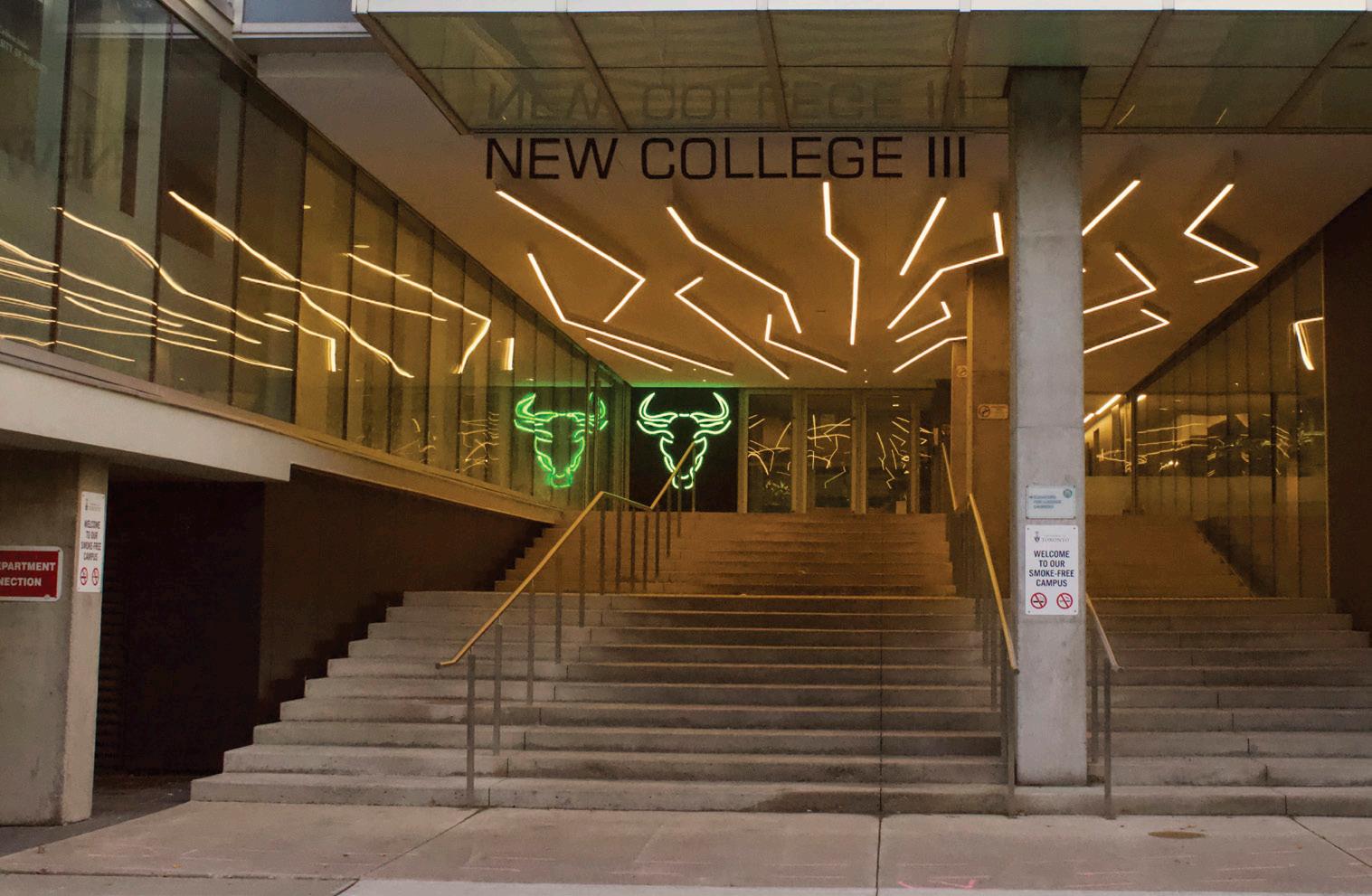
in the school… I can still use the dining dollars everywhere, but the amount is very limited.”
Design Editor
Vacant photos@thevarsity.ca
Photo Editor
Simona Agostino illustration@thevarsity.ca
Illustration Editor
Jennifer Song video@thevarsity.ca
Emily
emilyshen@thevarsity.ca
sataphon.ob@gmail.com
Vacant utm@thevarsity.ca UTM
Vacant utsc@thevarsity.ca
UTSC
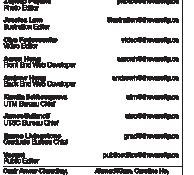
grad@thevarsity.ca
publiceditor@thevarsity.ca
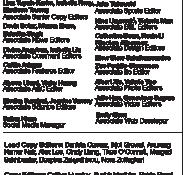

The $7,625 Unlimited Access plan offers unlimited swipes. The next two cheapest plans are Access 14 which provides 14 weekly visits for $6,925, and Access 10, which offers 10 weekly visits for $6,425. Entry swipes reset every Sunday and do not carry over to the following week.
In an interview with The Varsity, third-year New College resident and biochemistry student Cameron Kroll criticized the Access 10 plan, “10 meals a week — people can’t survive on that… It’s irresponsible to offer that as an option.”
Kroll also expressed frustration about the reset policy: “[Swipes] reset each week… I’m not here over reading week — doesn’t matter. I’m still paying for those meals. They don’t carry over.”
Students can also purchase food and beverages with Dining Dollars at participating locations such as Robarts Library, Sid’s, and the Medical Sciences Building. Since last year, Dining Dollars for the cheapest plan have dropped from $6,020 to $400, while the most expensive plans fell from $7,080 to $700.
TBucks — a form of campus currency — were cut from $100 to $50 across all plans.
Yida Li, a fourth-year biochemistry student living in New College residence, said, “In the past, we would have $5,000 or $6,000 Dining Dollars a year, and we could use it everywhere
Some students argue that the AYCTE branding of the Access Plan does not live up to its promise.
“In theory, it’s all you can eat,” said Kroll, “But if I decide that I would like extra meat on my sandwich, they aren’t going to give me extra meat. They control what you eat. If I wanted to have extra meat on my sandwich, I would have to go, get two sandwiches, throw out all but the meat from one, and combine.”
Lily Lee, a fifth-year resident, expressed mixed feelings about the change in an email to The Varsity, “I’m glad for this change… [but] with the AYCTE model, they’ve significantly scaled back variety, which generally isn’t good for dietary restrictions.”
Another major complaint among students is the shift to a limited take-out option. According to the New College Residence Access Meal Plan Terms and Conditions, students are limited to three takeout passes per week.
“I got yelled at for taking a bagel and a thing of fries out of the dining hall to eat in my room,” said Kroll.
Li added, “Sometimes, for example, I’m in an exam period. I prefer to eat in my dorm so I need to take [my meals] away. This year I can only do takeout three times a week.”
In an email to The Varsity, former Chestnut Residence Don Stephanie Gyimah said, “The
dons pushed strongly for UofT to reconsider the meal plan system… Of course, the push was met with significant contention.”
“It seems as though the same issues that plagued the pay-per-weight system continue to plague [AYCTE],” Gyimah added. “Students are still expected to ration their food and the vulnerability of students does not seem like it’s been properly taken into account.”
In a statement sent to The Varsity , a university spokesperson wrote, “The meal plans offered at New College are new this year. Meal plans were created in consultation with students and New College stakeholders. Meal plan options and policies are communicated to students prior to the residence application process,” and that, “the university does not receive funding from government or any other sources for its food services, which operate on a cost-recovery basis and not for profit.”
In 2020, Chestnut and New College residents boycotted the dining hall after the introduction of the declining balance model, fearing that students would run out of funds too early. At the time, the New College Council advocated reverting to a model similar to AYCTE, but without the limited swipes. In 2023, a pay-byweight model was implemented in all dining halls on St. George Campus operated by Food Services.
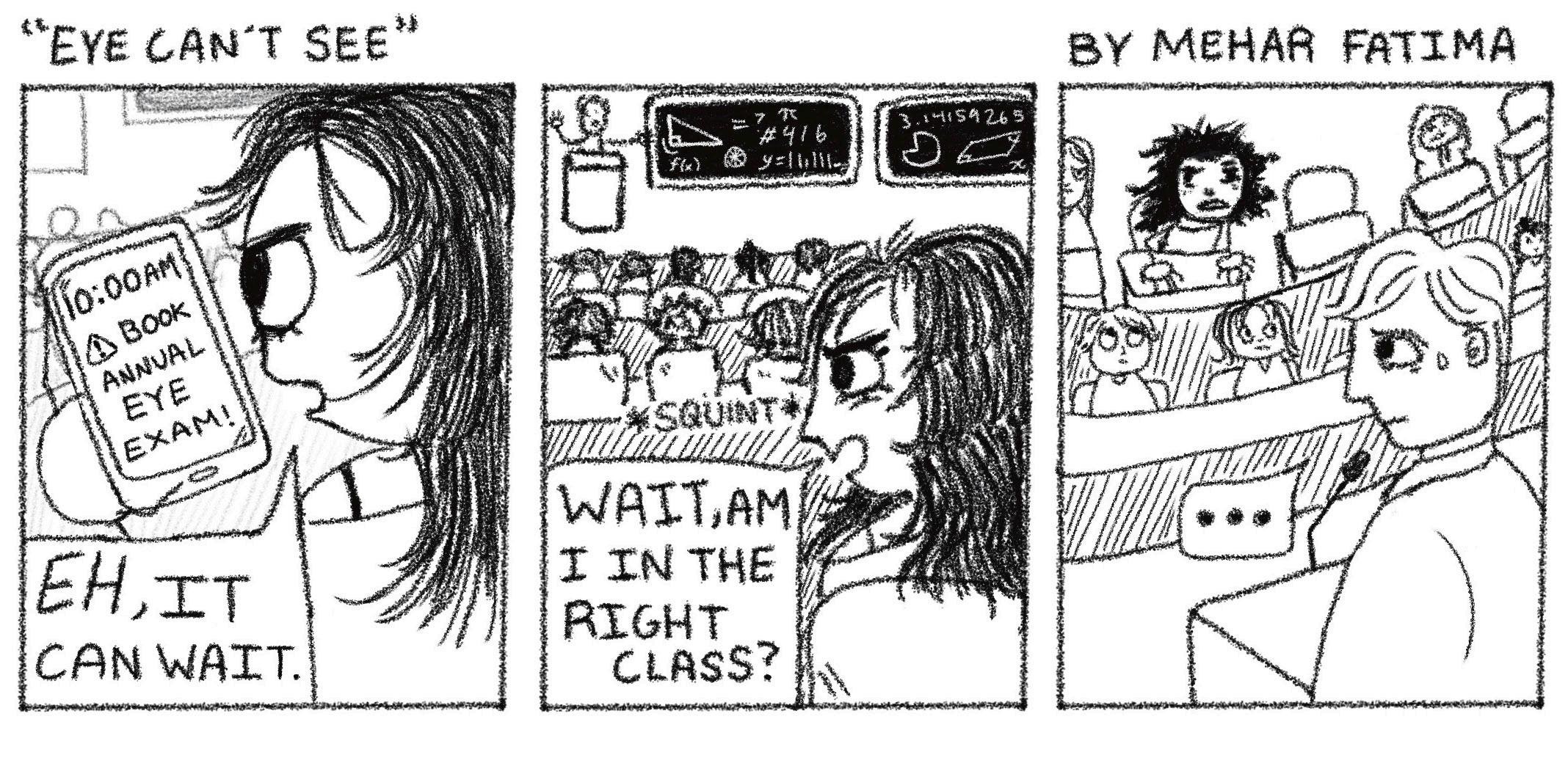
Students to Trinity College: Your
debt, not mine!
“After further conversation,” Trinity scraps $150 fee months after students request veto power
Devin Botar Varsity Contributor
In March, Trinity College proposed a new $150 ancillary fee agreement to the Trinity College Meeting (TCM), Trinity’s student government, which instead unanimously voted to delay approval and put an amended proposal to a college-wide referendum. Between May and September, Trinity College has scrapped the fee.
The money would have gone directly to the college with commitments for student life revitalization and student consultation. Trinity administration cannot raise the money itself due to a provincial-wide ban on increases to university tuition, so the agreement had the TCM introduce the ancillary fee instead.
College leadership underscored the need for a new fee by pointing to the significant debts accrued by Trinity from the construction of the new Lawson Centre for Sustainability.
It is not yet clear how the Trinity administration plans to make up for the revenue they sought to raise through a new fee. Kaelem Moniz, chair of the TCM at the time, claimed at a TCM meeting an administrator told him that without the fee, cuts to services and personnel would be inevitable.
Lawson Centre costs
The opening of the student residence and academic building, Lawson Centre for Sustainability, was originally planned for 2023. After several delays, the opening is currently planned for 2026. The Lawson Centre’s construction was initially estimated at $120 million, but the college’s latest audited financial statement projected that figure to be $177 million.
In a statement to The Varsity , a Trinity College spokesperson wrote that, “Even through pandemic-related challenges in construction
and supply chain management and rising construction costs, the project remains funded and on budget.”
To finance the project, Trinity secured a $15 million loan and $5 million in funding from U of T, as well as a $90 million loan from the Bank of Montreal.
Nicholas Terpstra, Trinity’s Provost & ViceChancellor, said at a TCM meeting in March that he hoped securing student approval for a new fee would show the Bank of Montreal that the college has the support of the student body.
A modest proposal
The proposed ancillary fee agreement included a slate of commitments by the college intended to “fund student experience initiatives and expand student spaces and services across the entire Trinity College campus,” according to a Trinity spokesperson.
The proposal promised student consultation, outlining the formation of a committee of student leaders and administrators, which would be consulted on “key decisions” around the dispensation of the ancillary funds.
One of the other commitments was for “mandatory quicker response times from the Dean of Students’ office.”
There was also a commitment to “recommend” to the Trinity College Board of Trustees, the college’s legal governing body, that student representation be increased on the board. Currently, four out of 28 seats are designated for students.
The March meeting
Rather than decide on the proposal when it was presented in March, the TCM voted unanimously to put the fee to a college-wide referendum in the fall.
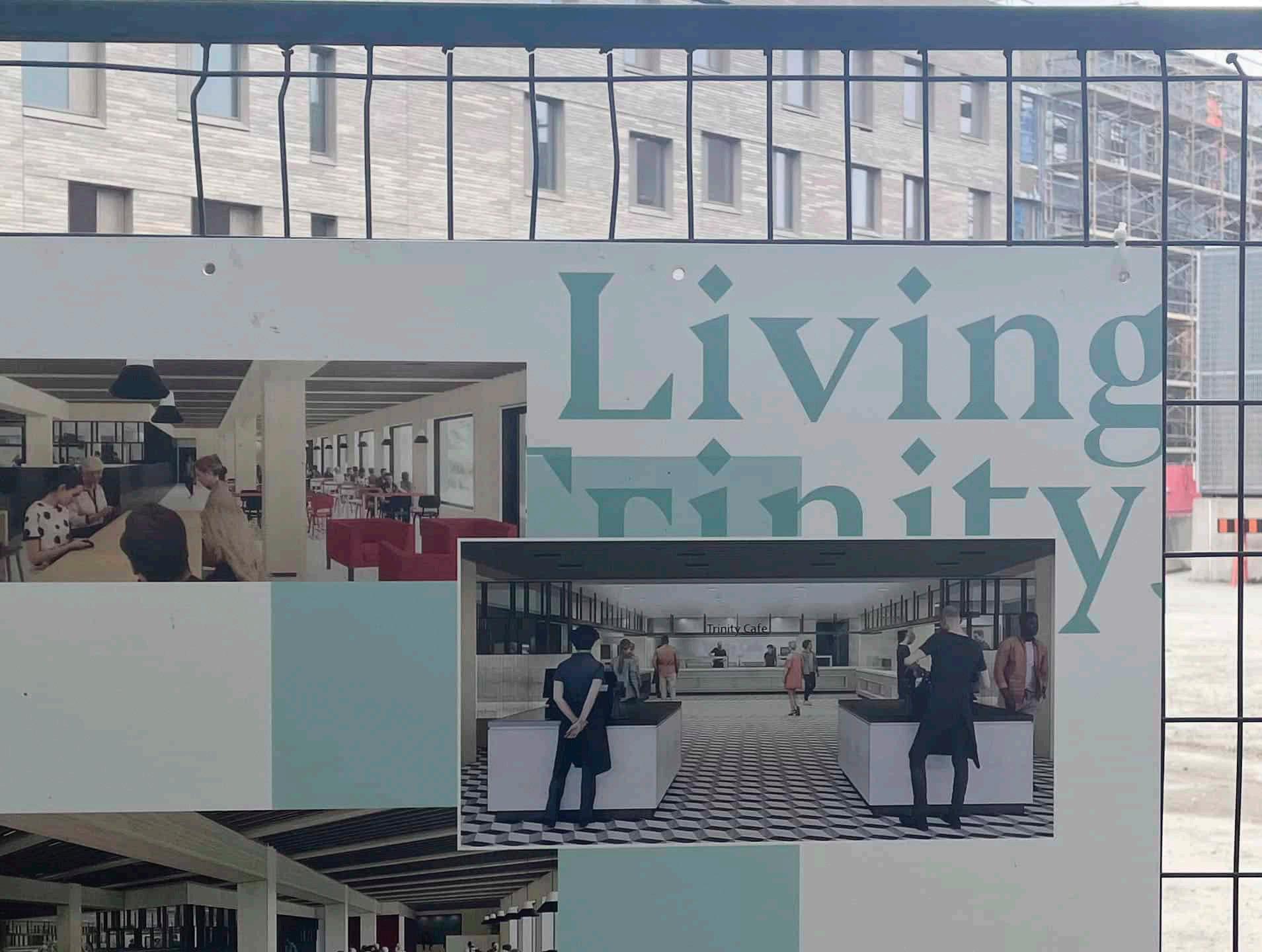
Alice Ferguson-O'Brien, a fourth-year cognitive science and philosophy student, is quoted in the TCM meeting minutes as saying, “The TCM, or some representative body, must have the opportunity to reject proposed spending if it does not align with student wishes. This is student money that could be going directly to the TCM - if we are going to give it to [the] admin, we must be actively included and consulted.”
In response to expanding student spaces, one student said, “There are common rooms on every floor of this building, there are common rooms in St. Hildas, and they aren’t open.”
Residence common rooms at Trinity, unlike at other colleges, are locked by default and must be reserved in advance to be used.
Referring to the commitment for faster email response times, one student asked, “Why do we have to give them any money for them to respond faster?” They continued, “This can just happen tomorrow… this kinda seems like a ploy.”
“It’s barely a ploy,” Moniz replied, “It’s what [the TCM leadership] have been able to put together to a degree that ensures maximum accountability.”
everybody needs to be involved in the process of this agreement.”
Discussions ongoing, then gone
On May 30, a Trinity spokesperson wrote to The Varsity that “Discussions are ongoing; and the College hopes students will support these new opportunities. If the agreement is approved by the student body, the levy would be implemented for the fall 2026 semester.”
Later on September 5, a Trinity spokesperson wrote to The Varsity that, “After further conversations this summer with undergraduates and student leaders of the Trinity College Meeting, Trinity has decided not to pursue a student levy at this time.”
Current TCM chair Anneke Lee, when asked about those conversations, wrote in an email to The Varsity “The administration’s reasoning for pivoting from the pursuit of a student levy is unknown to us, but it can only be assumed that the lack of support received at the March TCM indicated to them that - [Ancillary Fee Protocol] or not - a levy is not likely to be passed in the fall.”
“Win back student power:” Inside UTMSU’s commission against Bill 33 Students and Union express concerns about Bill 33 threat to EDI and student-run services
Mashiyat Ahmed Varsity Contributor
On September 24, the University of Toronto Mississauga Students’ Union (UTMSU) hosted its first Advocacy and Campaigns commission to educate students about Bill 33 — the Supporting Children and Students Act. Earlier this year, Ontario Minister of Education Paul Calandra introduced Bill 33, which, if passed, will significantly expand the provincial government’s oversight of public postsecondary education.
The proposed bill would give the provincial government control over which ancillary student fees are optional. Many student services at UTM rely on mandatory ancillary fees — including the student unions, U-Pass, Food Centre services, and student media like The Medium, The Varsity, and CIUT 89.5 FM.
As part of a coordinated effort with other unions, including SCSU and ASSU, the “Fight the Fees: Hands Off Our Education” campaign aims to stop governmental oversight of education, defend students’ right to organize, and advocate for increased government public funding for education.
During the event, UTMSU executives gave a short presentation on the origins of Bill 33, its proposed changes, and the union’s plans to mobilize against it. Afterward, students participated in a brainstorming session to develop actionable strategies for raising awareness about the bill.
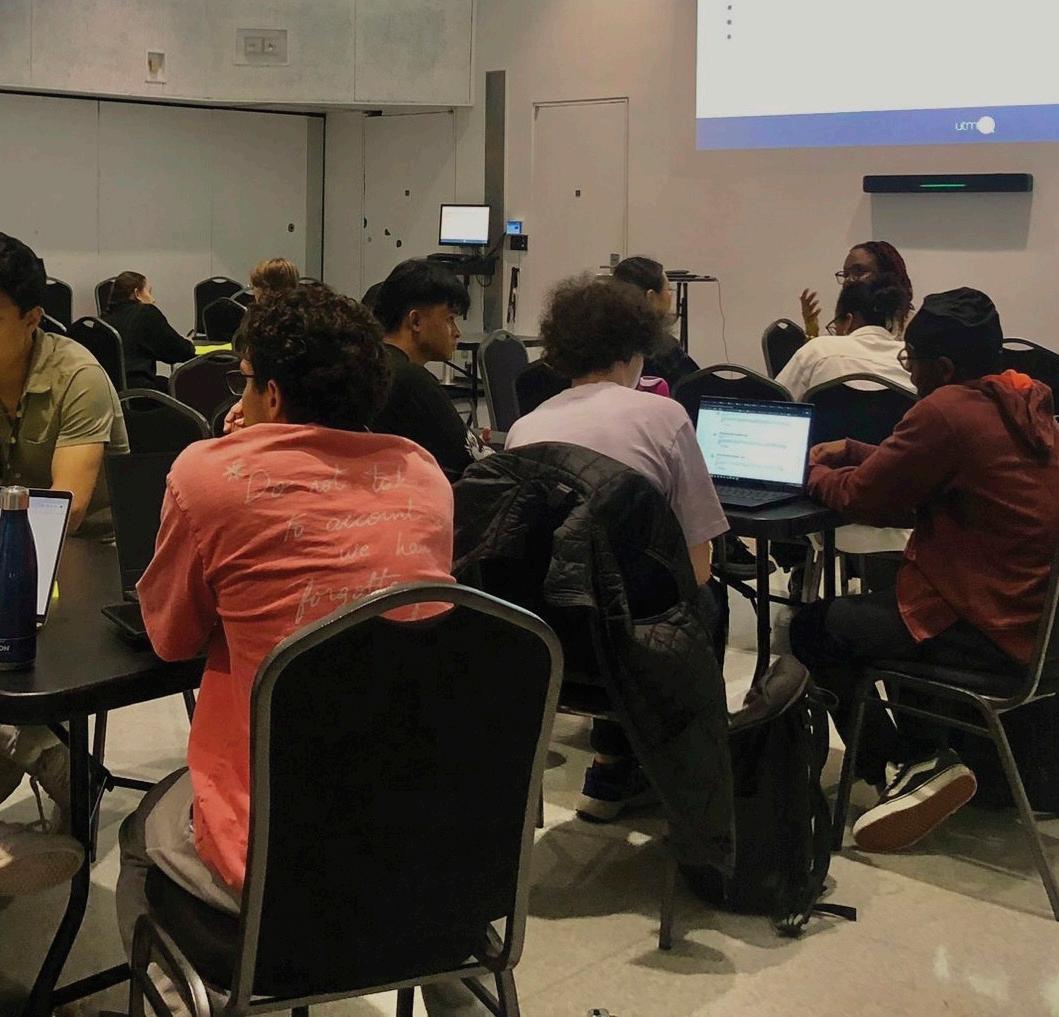
“Equality is not equity”
According to Miatah McCallum, VP Equity of the UTMSU, Bill 33 threatens many equity-based programs that support students, such as the UTMSU food centre.
“It is extremely crucial to fight against this bill, given that students across Ontario are experiencing food insecurity, underfunded mental health resources, and increased housing costs. Bill 33 is a threat to these very services which student unions fill the gaps for,” MacCallum wrote to The Varsity. MacCallum added that the UTMSU allocates funds for needs-based bursaries that cover transit, childcare, and emergency costs. “With Bill 33 in mind, these supports will cease to exist, which ultimately will make post-secondary education only available for those who can afford it,” she wrote.
Schedule 3 of the proposed bill would require post-secondary institutions to make admission decisions solely on the basis of “merit,” potentially eliminating other pathways to entrance. The bill does not define what constitutes merit. McCallum warned that this change could “reduce equityled initiatives and ultimately remove pathways set for students from racialized and marginalized backgrounds.”
The UTMSU is collaborating with other unions to organize walk-outs, rallies, bannerdrops, and protests during CFS’s Week of Action, scheduled for October 20–24.
Irish rap group Kneecap forced to cancel Canada shows amid government ban
Member Liam Óg Ó
Celesta Maniatogianni Varsity Contributor
hAnnaidh’s terrorism charge now been deemed “invalid”
Popular Irish hip-hop/rap trio Kneecap have been banned from entering Canada by the federal government ahead of their four soldout Canadian shows in October, two of which were planned for Toronto’s History venue. The ban comes after a series of public controversies and a terrorism charge against rapper Liam Óg Ó hAnnaidh by the UK government, which has now been thrown out due to a technical error.
Over the past few years, the group, originally from Belfast, Northern Ireland, has become known for its intense and unapologetic political activism, especially regarding the ongoing genocide in Palestine.
The group, comprised of members Liam Óg Ó hAnnaidh, Naoise Ó Cairealláin, and J. J. Ó Dochartaigh, who perform under the stage names Mo Chara, Móglaí Bap, and DJ Próvaí, respectively, have often used their live performances as opportunities to advocate for their beliefs.
Canada’s ban
On September 19, Canada’s parliamentary secretary for combating crime, Vince Gasparro, announced on behalf of the Canadian government that Kneecap would be “ineligible” to enter Canada.
In a video statement on X, Gasparro said that Kneecap have “amplified political violence and publicly displayed support for terrorist organizations” and that “Canada stands firmly against hate speech, incitements to violence, and the glorification of terrorism.”
Kneecap promptly responded to the decision in an Instagram post, saying that Gasparro’s comments are “wholly untrue and deeply malicious,” and that Kneecap will be taking legal action against Gasparro.
Kneecap wrote, “We will be relentless in defending ourselves against baseless
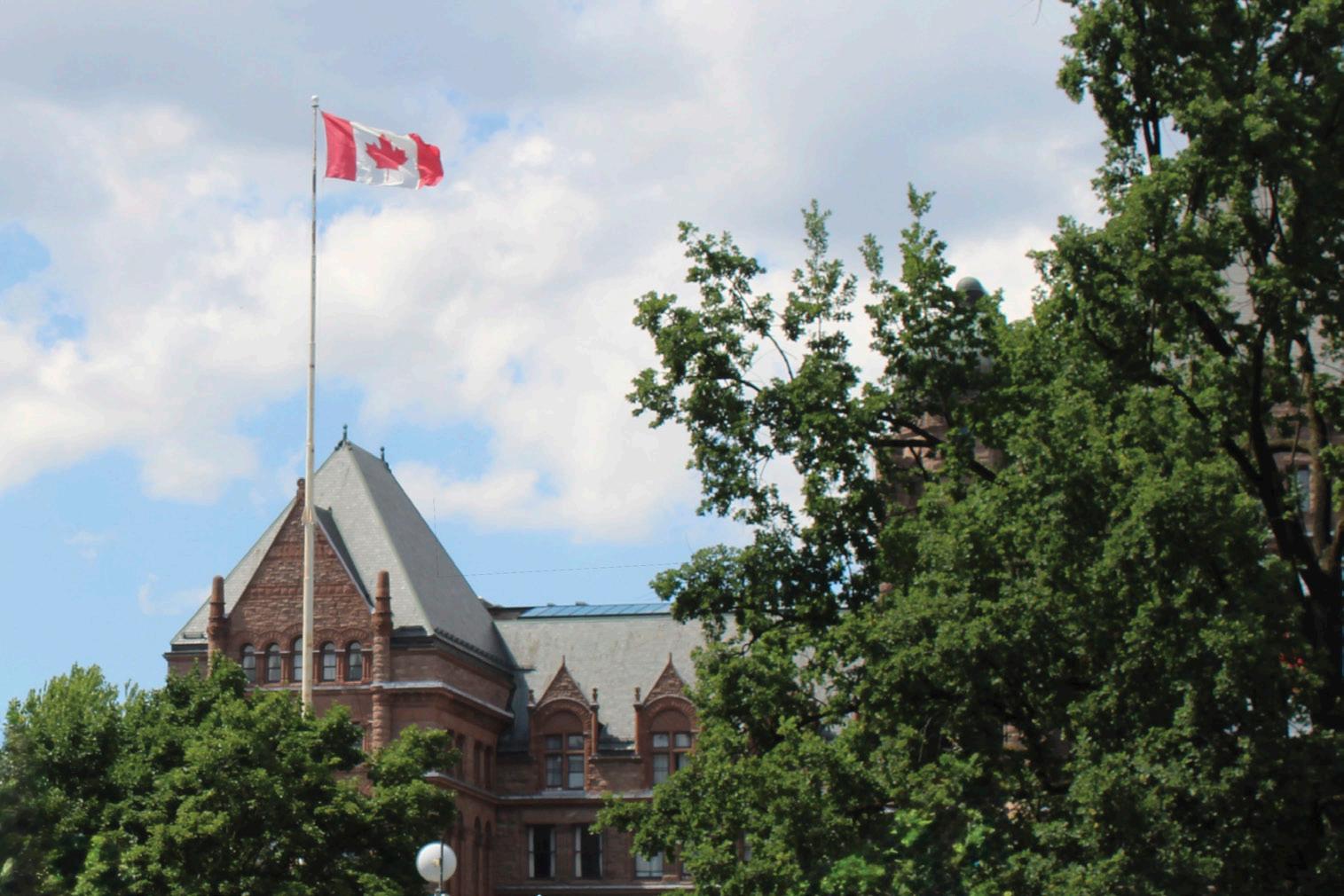
accusations to silence our opposition to a genocide being committed by Israel. When we beat you in court, which we will, we will donate every cent to assist some of the thousands of child amputees in Gaza.”
Terrorism charge
Kneecap were reported to counter-terrorism police by the UK-based Jewish group Campaign Against Antisemitism (CAA) after their sets at Coachella music festival in California last April featured messages on screens such as, “Israel is committing genocide against the Palestinian people,” and “Fuck Israel, Free Palestine.”
During one of their performances, the group led the crowd in chanting “Free, free Palestine,” and Chara criticized the Israeli government for its bombing of Gaza, saying, “The Palestinians have nowhere to go. It’s their fucking home, and they’re bombing them from the skies. If you’re not calling it a genocide, what the fuck are you calling it?”
CAA also cited a concert video from November 2024 in which Chara is allegedly seen draped in a Hezbollah flag and shouting “up Hamas, up Hezbollah.” Hamas and Hezbollah are both classified as terrorist organizations by both the UK and Canadian governments.
Chara has said that the flag was thrown onto the stage, and in a statement on Instagram, Kneecap said that they “do not, and have never, supported Hamas or Hezbollah,” and that the November concert footage was “deliberately taken out of context.”
Chara was formally charged with terrorism in May and appeared in court on August 20, where he sought to have the charge thrown out. Last Friday, Chief Magistrate Paul Goldspring ruled that the terrorism charge against Chara was “unlawful” and “null” due to a technical error: the November 2024 concert footage was outside of the 6-month statutory time limit required for such charges.
Graduate Directors renew partnership with U of T Food Coalition, pass 2025–2026 budget
UTGSU’s Annual General Meeting will be held on December 4
Matthew Molinaro Graduate Bureau Chief
On September 22, the University of Toronto Graduate Students’ Union (UTGSU) presented its 2025–2026 budget and announced a new partnership with U of T Food Coalition at the monthly Board of Directors (BOD) meeting.
Budget
Vice President (VP) Finance Farshad Murtada and administrator Nusrat Huq delivered a presentation on the two-million-dollar 2025–2026 UTGSU budget, opening with, “it’s that time of the year again, where we do a deep dive into the madness known as the UTGSU budget.”
UTGSU revenue was previously listed as $20 million, $17.5 million of which came from Health and Dental Premiums. This year, Health and Dental Premiums are listed separately to better reflect the union’s revenue and expenses.
Murtada noted several factors from the past year that impacted projections for 2025–2026, including the reopening of the Graduate Student Union Building, a full programming year with multiple active caucuses, a complete staff team, and an increase in grants and programming, such as the student conference bursary.
In response to a question from Division
Three Director Amir Mohammed Zadeh, Huq clarified that the 2024–2025 audit has not yet taken place and is scheduled for this October.
U of T Food Coalition
An adopted motion allocated $14,000 in partnership with U of T Food Coalition to expand its meal program. UTGSU executives will prepare a memorandum of agreement with the Food Coalition before the next BOD meeting.
According to U of T Food Coalition representative and Geography and Planning PhD candidate Mike Lawler, the Food Coalition has served 1,400 free meals to students with an entirely volunteer-run staff. The coalition offers organizing and placement opportunities for students through programs such as the CSE342 — Theory and Praxis in Food Security course. The Free Meal program works closely with local grocers and independent businesses to support sustainable purchasing.
In the five-year plan developed by coalition members, the program aims to offer a daily free lunch, build a commercial kitchen, and begin paying staff members.
Other business
David Kim, lecturer at Ontario Institute for Studies in Education (OISE) and Hart House
Warden, provided updates on the Hart House renewal project, highlighting the need for more efficient systems, updated technology and infrastructure, improved accessibility, and increased student awareness of the project.
VP Dominic Shillingford confirmed that the UTGSU Annual General Meeting will be held on Thursday, December 4, at 6:00 pm in the Multi-Faith Centre.
The Varsity Newswire
Canada recognizes Palestine as a state — Ottawa
On Sunday, September 21, Canada became the first G7 country to recognize Palestine as a state. In a statement released that morning, Prime Minister Mark Carney’s Office offered Canada’s “partnership in building the promise of a peaceful future for both the State of Palestine and the State of Israel.”
U of T to commemorate Orange Shirt Day with keynote address, ceremonial fire — Hart House On Tuesday morning, UTSG, UTSC, and UTM will come together to commemorate Orange Shirt Day and the National Day for Truth and Reconciliation with a ceremony in Hart House’s Great Hall. From 10:00–11:30 am, Hart House Warden David Kim, President Melanie Woodin, and U of T Vice President and UTSC Principal Linda Johnston will deliver remarks.
and members of the indigenous community are welcome to join.
Chow pushes back against Ford’s speed camera ban — Toronto On Friday, a Toronto city committee approved Mayor Olivia Chow’s motion to bolster automated speed enforcement in the city, sending the recommendations to city council for a vote. This comes only a day after Ontario Premier Doug Ford announced a plan to ban speed cameras in the province.
Canada Post on strike nationwide after threat to home delivery, rural outlets — Ottawa The Canadian Union of Postal Workers called for a nationwide strike on Thursday afternoon. Prior to this, the federal government had ordered the end of home delivery and the closure of some rural mail outlets, as part of announced reforms to Canada Post.
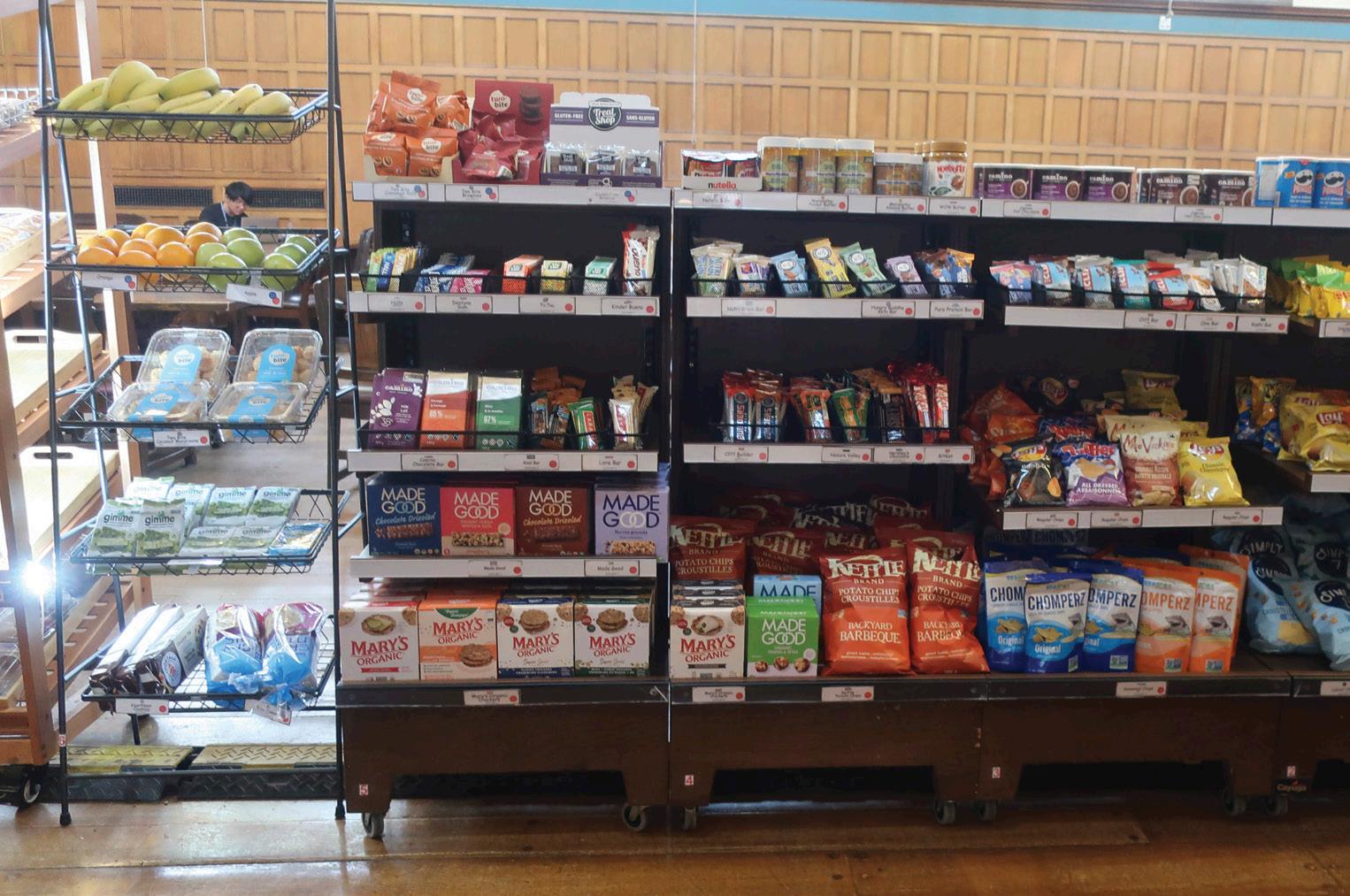
Business & Labour
Wes Hall, U of T’s 35th chancellor
September 30, 2025
thevarsity.ca/category/business
biz@thevarsity.ca
Diving into Hall’s life from growing up in the Caribbean to having a successful
career in Canada
Medha Barath Business and Labour Editor
Continued from cover.
The BlackNorth Initiative
Hall was inspired to take further action against racism after the death of George Floyd in 2020. He wrote an article in The Globe and Mail titled “When I look in the mirror, I see George Floyd – and so do others.”
In the article, Hall reflects on how Black people continue to face systemic racism regardless of their success. He recalls being hesitant to help an elderly white woman who had fallen in his neighbourhood — fearing that police might misinterpret his intentions, or that she would be startled by a Black man offering help.
After the article was published, Hall began to receive calls from various business executives asking him how they could help. “At the end of the day, I said, let’s do something about it,” said Hall.
This led him to create the BlackNorth Initiative, which works to end systemic antiBlack racism. One of its main goals is to improve the representation of Black Canadians in boardrooms and executive positions. Now in its fifth year, the initiative also offers programs to expand access to early career opportunities, affordable homeownership, and other funding resources for underrepresented groups.
Life at U of T
Since coming to U of T, Hall has been amazed by the diversity of the student body. “I sit there in Convocation, I see the [graduating] class, and it’s like the United Nations,” he said. This experience has inspired him to dedicate even more time to his diversity initiatives, like BlackNorth. “Now that I see this up close, it empowers me more to continue to do what I think I need to do, to build allyship so that their struggles are not as difficult as my struggles.”
Hall’s goal as Chancellor is to leave “an impact that is good for the institution.” He specifically wants to challenge the stigma surrounding
academia.
“[Academia] is under attack. We see what’s going on in the United States, we see even what’s going on in Canada… but [academia] is the future of our country… it shouldn’t be under attack. It should be embraced and empowered.”
He hopes to address this by leveraging his ties to the business world. Ultimately, Hall wants U of T to stand as an example to the rest of society — not as an institution under fire, but as one embraced as a guide for the future.
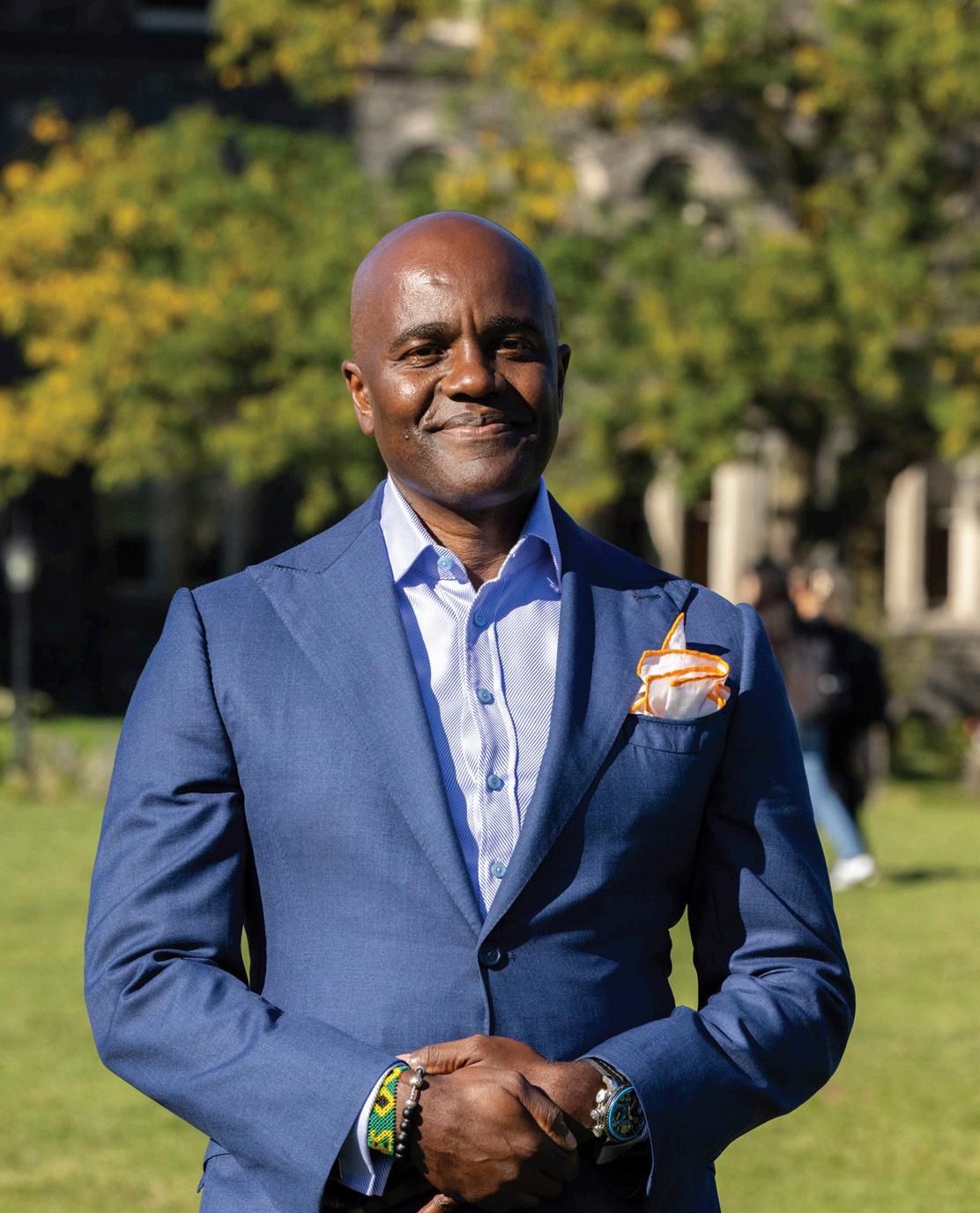
Student enrolment and construction plans: An overview of the Planning and Budget Committee
Committee discusses plans for buildings AI readiness, MacMillan Theatre, multi-year accessibility plan

Student enrolment continues to be a concern for U of T. While domestic enrolment is rising, a decline in international students is putting additional pressure on the university’s budget, according to the first Planning and Budget Committee meeting of the year.
The meeting also provided updates on the university’s construction projects, including the long-awaited renovation of the MacMillan Theatre, and highlighted efforts to make the campus “AIReady.”
Student enrolment
This year, approximately 100,000 students are enrolled at U of T, including 17,000 new undergraduates and 8,000 new graduate students.
Although total enrolment is close to targets, the composition of students has changed significantly. For at least 15 years until 2024, U of T had been seeing a steady increase in international student enrolment, while domestic enrollment remained largely frozen due to government funding limits. This trend has now reversed.
Domestic enrolment is eight per cent above the target of 49,915 students this year. While this increases domestic tuition revenue, it does not necessarily benefit the university’s budget. U of T receives an operating grant from the government for domestic students, but the university is nearly 1,000 students above the threshold for which the government provides funding.
At the same time, international enrolment is declining. International undergraduate enrolment is 19 per cent below target, with five to six per cent fewer international students than the previous year. Declining applications from Chinese and Indian students are a major factor in this reduction.
This follows a continuing trend from last year, when the share of international student enrolment fell by 0.7 per cent compared to the 2023–2024 academic year, even though the total number of international students increased slightly.
Interest in U of T’s programs is also shifting. Enrolment in computer science has declined for the second consecutive year, while business and commerce remain popular. UTSC’s Life Sciences program has seen increased interest, possibly due to targeted recruitment efforts.
Overall, these changes in enrolment are negatively affecting U of T’s budget, which is facing a $50–$60 million shortfall from its projected $3.62 billion in revenue. While contingencies will help the university function for now, U of T plans to recalibrate enrolment targets and revenue projections to account for declining international student demand.
AI-ready campus
In 2024, U of T introduced the AI Task Force to ensure the responsible integration of AI across the university. The task force’s report was compiled following consultations, town halls, focus groups, and an employee survey.
At the meeting, U of T highlighted several AI literacy initiatives already in place. Educational modules available on Quercus received more than 1,800 unique visits and 520 downloads. The university has also provided community members with secure access to AI tools, such as Microsoft Copilot, and has launched pilot projects with virtual tutors.
U of T is also introducing AI Kitchens, a secure, multimodel virtual environment equipped with AI tools and data access, designed to support the testing and implementation of advanced AI projects with technical and process support from the university.
U of T project planning
The university has several upcoming building projects. A particularly significant undertaking is the Temerty West Wing Building, which will replace the west wing of the Medical Science Building. The investment in this project quadruples any previous construction investment made by U of T.
The university also shared updates on a planned building at 90 Queen’s Park Crescent, which will be named the Center for Cultures and Civilizations and will house the School of Cities and other spaces.
The building was initially approved at a total cost of $165 million, but costs rose substantially to over $250 million due to COVID-19, supply chain pressures, and construction costs. Toronto’s high demand for construction — the city consistently has the most construction cranes in North America, contributing to higher prices. As a result, the university has decided to scale back the project and construct a similar building.
The MacMillan Theatre is a key performance venue with 815 seats and a history of hosting over 600 shows annually. The theatre has been closed since December 2023 due to maintenance and safety concerns and is currently undergoing renovation.
Once complete, the theatre will serve a dual purpose: it can function as a classroom space during weekday mornings and as a performance venue at other times.
Current building plans include the replacement of equipment, the fire curtain, and rigging systems used for hoisting equipment. These upgrades aim to improve operational efficiency and safety, helping to prolong the building’s lifespan.
The MacMillan Theatre is scheduled to reopen in September 2026.
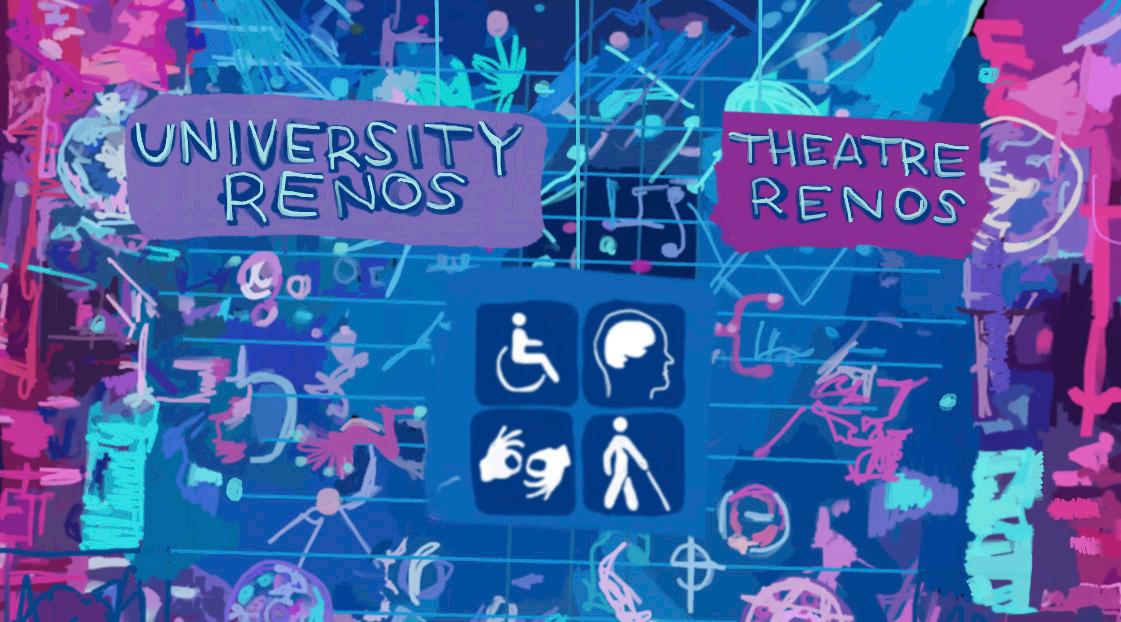
September 30, 2025
thevarsity.ca/category/opinion opinion@thevarsity.ca
We need more
Black Physician Assistants
It’s time for universities to create pathways for Black PAs
Shelda Habyarimana Varsity Contributor
I am one of only two Black women in my Physician Assistant (PA) program.
In a classroom of future healthcare providers, the absence of Black faces mirrors the broader landscape of Canadian medicine. Increasing not only the number of Black, Indigenous, and people of colour (BIPOC), but specifically Black PAs, is key to facilitating safer learning environments, improving patient care, and addressing systemic racism in medicine.
For the students
I remember the first day of classes like it was yesterday. Coming from a marginalized community, I’ve developed a habit of scanning a room ahead of time to mentally prepare myself to be the only Black person in a room, a routine I’ve known since childhood as a daughter of immigrants living in the suburbs.
With so few Black students in many health programs, microaggressions and isolation often go unnoticed and unaddressed. Students are frequently left to challenge outdated or biased content in the curriculum on their own. These experiences are not isolated but part of a larger trend among minority trainees. A 2020 Yale study published
in JAMA Internal Medicine found that US medical trainees of underrepresented identities face disproportionate mistreatment from peers and supervisors. As Black Canadian students, we are not exempt from this racist and misogynistic treatment.
Despite this reality, PA programs have not developed dedicated application streams to support Black students, unlike many medical schools. Programs like the Black Student Application Program (BSAP) at U of T’s Temerty Faculty of Medicine are designed to reduce systemic barriers, offering Black applicants access to mentorship, targeted resources, and representation in admissions through the involvement of Black faculty.
I believe that similar initiatives must be implemented for pre-PAs, or else we risk reproducing a form of exclusion that has long existed in medical education in Canada.
For the patients
Anti-Black racism remains deeply embedded in our healthcare system. This is something I’ve witnessed firsthand and that research continues to affirm. Anti-Black racism contributes to disparities in pain management, mental health diagnoses, and maternal outcomes for Black patients. For example, a 2016 study by the University of Virginia found that a cohort of about 400 medical students
rated Black patients’ pain to be lower than that of white patients, despite using the exact same description of symptoms. Implicit biases like these have contributed to the Black maternal health crisis in Canada.
According to the 2016 census, Black Canadians made up about five per cent of Ontario’s population in 2015, but only two per cent of physicians identified as Black. This gap isn’t just statistical. It means many Black patients never see themselves reflected in their providers.
A 2018 National Bureau of Economic Research study shows that Black patients are more likely to trust and engage with providers who share their backgrounds. By introducing more Black PAs, we create opportunities for improved rapport, better adherence to care plans, and stronger health outcomes for the underserved.
For the profession
To say the least, Canada’s healthcare system is overwhelmed. According to Statistics Canada findings, nearly 2.5 million people report unmet healthcare needs. Over five million Canadians struggle to access care. And as of December 2024, the country hit a record-high median wait time of 30 weeks between referral and treatment.
PAs are a proven part of the solution. PAs are advanced practice clinicians who
work with physicians to deliver a wide range of medical services, from diagnosing and treating illnesses to improving access to care. PAs reduce length of stay, improve discharge rates, and increase continuity of care.
While the profession is growing, we need to be intentional about how it grows. Our workforce should reflect the diversity of the patients we serve. Hiring and supporting more Black PAs won’t just ease staffing shortages, but will help fill a deeper, more systemic gap in representation.
For the future
A healthcare system cannot be equitable if it does not reflect the people it serves.
We cannot build a stronger, more equitable healthcare system without ensuring that Black voices and perspectives are part of it.
Yes, increasing the number of PAs is important, but increasing the number of Black PAs is essential. By actively recruiting, supporting, and empowering Black students, our institutions can create a profession and a healthcare system that truly serves all Canadians.
Shelda Habyarimana is a second-year Physician Assistant student at the Temerty Faculty of Medicine, with a background in health sciences. She is passionate about advocacy, representation in healthcare, and inspiring more young Black women to pursue careers in medicine.
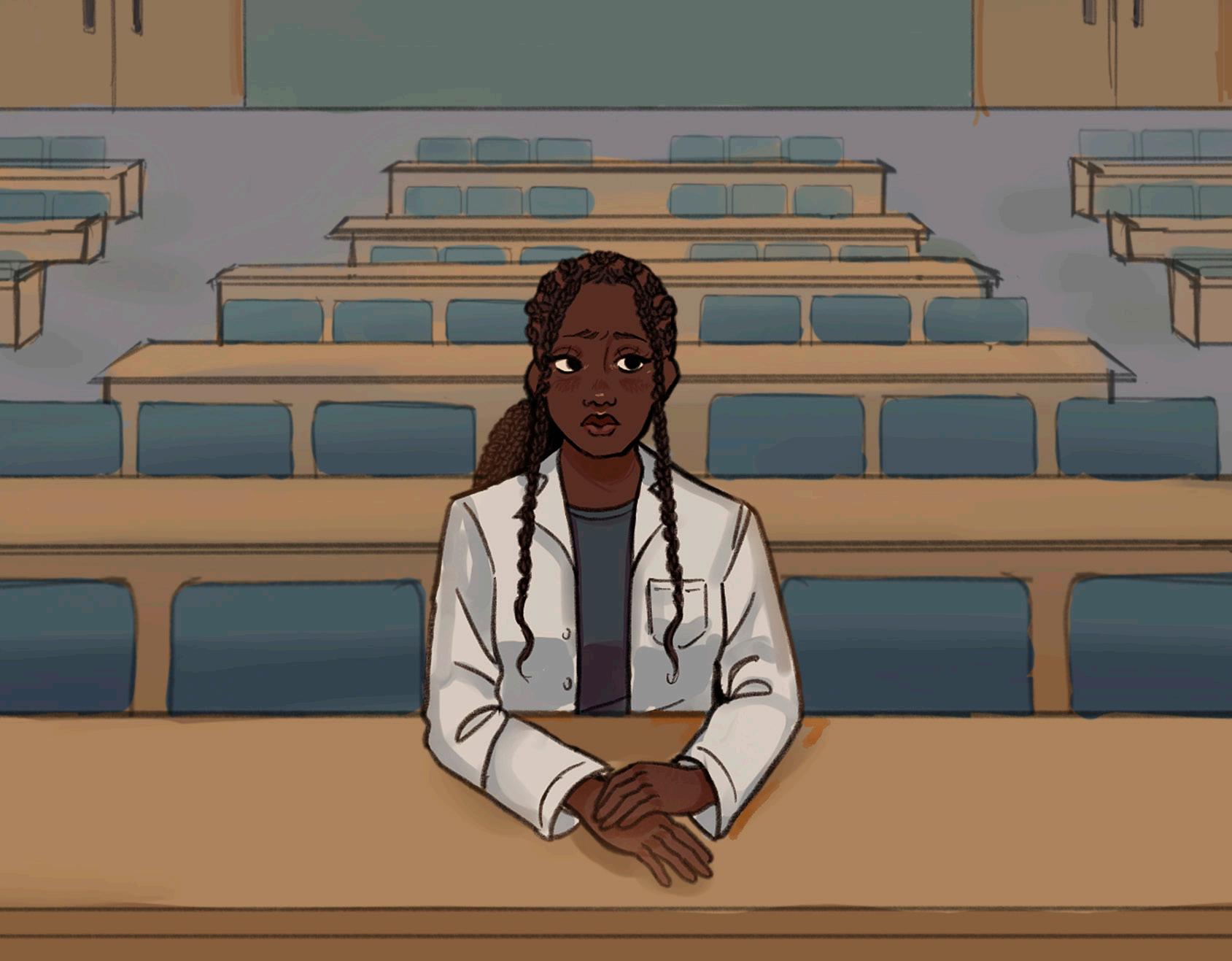
The loss of the federal NDP
How the NDP’s identity crisis and Canada’s two-party system left voters with no choice

Jazmeet Saxena Varsity Contributor
In the recent Canadian federal election, the New Democratic Party (NDP) was stripped of its momentum. They not only lost official party status, but also saw Jagmeet Singh resign as party leader after losing his seat in his riding of Burnaby Central.
For some, these changes may seem like part of a natural course in politics, where parties rise and fall all the time, but this isn’t just a story about one party losing power. I believe that the NDP’s collapse is a symptom of a deeper structural failure within Canadian democracy.
I believe that, during the 2025 federal election campaign, Singh threw mixed messages about the NDP’s previous and future support for the Liberal Party’s agenda, leaving voters feeling like they must vote strategically between two popular parties. I also feel that the NDP’s alienation from its voters and its identity crisis were exacerbated by the mainstream media’s failure to provide coverage on smaller parties, further reducing the ideological political spectrum within the Canadian democratic system.
This problem is larger than just the NDP; it lies within the core of our system.
The two-party system
The dilution of Canada’s multiparty system during this election wasn’t unpredictable. In theory, Canada’s electoral system should offer a chance for diverse parties to grow, evolve, and represent different voter interests. However, it was clear from the start that the choice in this election was between the Liberal and Conservative parties.
Currently, our political system has become largely divided between the Conservatives and the Liberals. The focus on these two parties shuts out other voices, leaving little chance for any other parties to garner attention. I think that as our elections become a fight between two sides, we lose the meaning of how Canada’s democratic system is supposed to work.
Many people don’t entirely support the Liberals or the Conservatives. Yet, they vote for one out of fear that the other may win. These voters worry that if they vote for a less popular party –– such as the NDP –– their vote won’t ‘count’ in the grand scheme of the election, leading to a win for a larger party that they dislike. So, instead of choosing the party that aligns with their values, voters cast their ballots for the lesser evil among the more prominent parties.
This kind of thinking implies that people’s true choices don’t matter, which prevents any real change from happening. When this pattern of voting persists, it leads to non-major parties losing power, such as in the case of the NDP.
NDP’s identity crisis
In addition to the impacts of strategic voting, I don’t think that the NDP’s identity crisis helped the party’s situation either. While the NDP has tried to appear as a more progressive alternative to the Liberal Party, their past support for Trudeau has entirely weakened this message. As a result, Singh’s recent attempt to attack Trudeau mostly came off as disingenuous.
On January 7, Singh, in a statement on Trudeau’s
resignation, stated that the Liberal Party has “let down Canadians” and “do not deserve another chance.” Yet on March 22, 2022, he signed a deal to keep Trudeau in power until 2025 in exchange for progress on some of the NDP’s priorities, such as pharmacare and dental care.
By previously backing the Liberals, the NDP blurred the line between being its challenger and its partner. I believe that this confusion greatly hurt them in this recent election, allowing the NDP to go from being partners of the Liberal Party to barely holding on to power after losing party status.
The NDP’s mixed message regarding their support of the Liberals made it difficult for voters to trust the NDP’s leadership. Those who wanted the party to be a clear alternative to the Liberals felt betrayed or confused as to what they truly stood for.
At the same time, those who were skeptical of Trudeau’s government saw the NDP as part of the problem rather than the solution. Yes, they wanted to push their own policies while working with the Liberals. But in doing so, they surrendered their independence in the eyes of Canadians, giving voters the impression that the parties were too similar.
Media visibility
The NDP itself isn’t the only one to blame for its decline in votes. Political narratives are largely shaped by the media coverage; it’s easy to see that most of the mainstream coverage focused on emphasizing a race between the Liberals and Conservatives, sidelining the NDP.
Despite the NDP’s efforts to represent bold policy ideas such as wealth taxes, expanded health
care, or climate justice, their messaging struggled to break through. Reporters often framed the election as a two-way fight, leaving less space for others to compete/participate.
Even during televised debates, moderators directed the attention towards Mark Carney and Pierre Poilievre, treating Singh like a third wheel. In the English-language debate, which was aired on April 17 by CBC, Singh spoke for the least amount of time, falling significantly behind Poilievre and Carney.
Media coverage doesn’t just reflect public interest; it shapes it. If people don’t hear about NDP policies, they may assume the party doesn’t have a relevant plan. Media visibility matters, and within this election, it was lopsided.
When alternative voices are sidelined, it contributes to a shallow form of democracy; one where bold ideas are ignored and only the most ‘electable’ stories are told. In such a climate, it’s no surprise that the NDP struggled to be seen as a serious voting option.
Moving forward, the NDP needs to rethink how it connects with voters and what it truly stands for. Instead of latching onto other parties, they need to establish a clearer message about their goals and values. If this pattern continues, it risks undermining the multi-party system at the core of our democracy.
People need to know exactly what the NDP has to offer that other parties can’t. This means standing firm on their promises and defining themselves again without confusion or compromise.
Jazmeet Saxena is a second-year student at UTSC studying journalism.
Nationalism serves the powerful, unity serves the people
Zaneb Asad Associate Opinion Editor
Donald Trump recently returned to the Oval Office with the national popular vote. Since his inauguration in January, he has already ignited a trade war with Canada, their northern neighbour — mommy and daddy are fighting again.
From 25 per cent tariffs to conversations about Canada becoming America’s 51st state, the reactions from Canadians have been varied. Many Canadians have responded by boycotting American products and indulging in patriotic discourse. This, I think, raises questions about the usefulness of national pride and how it differs from nationalism.
I believe that nationalist movements often function as a defence mechanism rather than a pragmatic response to external economic or political threats, much like the ones Canada is facing now. While I believe nationalism can unify people in times of crisis, it can also be blinding to the flaws of a state, rather than being a tool for constructive civic action.
As opposed to falling into performative nationalism, like flag-waving and booing the American anthem, which encourages an ‘us versus them’ mentality, Canadians should focus on local unity. This refers to practical and targeted actions like boycotts and supporting local communities and businesses to fight against these challenges, to ensure that we build a peaceful resistance through working together, rather than reacting with a haughty nationalistic sentiment.
The tariff war
News outlets have been buzzing for months about how the Canadian economy could be affected by Trump’s tariff threats. In essence, tariffs are a tax that a country imposes on imported goods. Oil and gas extraction, crop and animal production, petroleum refineries, and automobiles are generally some of the major Canadians industries to be affected. For example, the 25 per cent tariff on automobile and vehicle manufacturing will make Canadian exports less competitive in the American market by creating an estimated additional cost of 13.3 billion. The US imposing tariffs could trigger a chain reaction of rising costs for Canadians, which will lead to reduced demand.
Reduced demand is bound to slow down the economy, resulting in higher unemployment and a further erosion of economic demand and health. Looking ahead, these consequences will further strain the relationship between Canada and the US, especially in terms of trade. Importing and exporting activity has a substantial influence on GDP, exchange rates, inflation, and interest rates. Trump getting rid of the tariffs is unlikely, as he continues to propose new tariffs, including a 100 per cent tariff on pharmaceutical drugs.
In February, now-former Prime Minister Justin Trudeau told CBC that “the government has to take US President Donald Trump’s threats to annex Canada seriously — even if it’s never going to happen.”
Natalie Stechyson from CBC News reported in March that many Canadians were worried about the upcoming tariff war, referring to “Trump’s policies

and what seems like an unending onslaught of bad news.” However nerve-wracking this situation may be, I believe the masses can assert their power and autonomy by changing the way they spend their money.
The goal in boycotting American products is to not have to rely as much on American products and regain a part of our economic autonomy. People across the country have been working together to boycott American products — which outlets such as Forbes have proved to be effective.
National pride or nationalism?
It is often a slippery slope when national pride evolves into nationalism and leads to ineffective protesting, such as the booing of the American national anthem, since the sentiment behind it comes from a place of revenge, not unity. I believe that unity with the people around us, rather than upholding a nationalistic Canadian view, is the way forward.
While some may argue that boycotting American goods is a form of nationalism, I think the distinction between national pride and nationalism
lies in its intent. Actions such as boycotting American products, supporting Canadian brands, consuming Canadian entertainment, and travelling locally aren’t about proving Canadian superiority but about tangible support and fostering unity for local growth.
I am grateful for my community, and the resilient people and communities that live in Canada. But am I proud of the country itself? Meh! My gratitude and pride for the country I live in are not the same thing. I love where I live, but does that mean I need to be proud of the country itself? If so, what is there to be proud of?
I think it’s worth questioning what we attach our pride to. Blind loyalty to one’s country may be a comforting, yet an alarming thought — however, unity with the people around us will always be what truly gets us through times of crisis.
Zaneb Asad is a fifth-year English, Political Science, and Creative Writing student at
She is also a copy editor and Associate Opinion Editor at The Varsity
feel they aren’t getting the most out of their money
A different kind of ‘leftovers ‘ : U of T meal plan money Students
The new school year at U of T is now in full swing, which means so are the ovens, stovetops, fridges, and pantries that produce the daily dining hall food enjoyed by thousands of students across campuses. Whether you’re settling in for a few hours of dining and studying at Trinity College’s Hogwarts-esque dining hall or popping into the Arbor Room for a quick bite before class, you can use your meal plan dollars all around U of T.
Meal plans are meant to serve students not only food, but also convenient and accessible on-campus dining options. However, these plans have sparked many concerns among students about the flexibility, resourcefulness, and value of their meal plans — all in relation to the common issue of leftover meal plan money.
Students have continuously agreed upon the issue; the end of the academic year is approaching, and they have way too much money left on their meal plans. One student took to the r/UofT Reddit page to express their frustration with having $4,000 left over on their meal plan, and only 15 days left in the term to spend it all. A similar situation had a student stressed with only six days to spend $650 at their dining hall.
These frequent scenarios have led to questions that linger in many students’ minds: Why do so many of us have so much money left over on our meal plans? Is the U of T meal plan truly worth the cost? What has U of T done, if anything, to address this?
The basics: How meal plans work
By looking at the basics of meal plan requirements for each U of T campus, we can start to understand why leftover meal plan money is such a common issue.
All three campuses have mandatory meal plans under certain terms. Some of UTSG’s colleges have mandatory meal plans for residents. These include Chestnut Residence, CampusOne Residence, Knox Residence, New College, Oak House, St. Michael’s College, Trinity College, University College, and Victoria College. For students living in residence, there are two types of meal plans available: the “declining balance” meal plan and the “all-you care-to-eat” meal plan.
With a declining balance meal plan, students are given a fixed balance that declines as they get more meals, depending on the number and kinds of meals they get. Alternatively, the allyou-care-to-eat plan gives students access to a dining hall where they can eat as much and whatever they want from what is available each visit. The majority of UTSG meal plan fees are $7,625 for unlimited use for the 2025–2026 year.
At UTSC, all first-year students who live in residence are on a mandatory, all-access meal plan at the dining hall in Harmony Commons. All-access meal plans go up to $6,610. Upperyear students “have the option to purchase a meal plan but are not required to do so,” as specified on the UTSC Student Housing & Residence Life website.
UTM students must have a meal plan if they live in residence, no matter what year of study they’re in. The cost decreases in order of “Plus,” “Full,” “Light,” and “Minimum”-style meal plans, with prices ranging from $2,950–$5,525. While upper-year students have access to all four meal plan styles, first-years only have the options of “Plus” and “Full”, making the plans overall more expensive for them
One of the clearest reasons why so many students end up with high amounts of leftover meal plan money near the end of the school year seems to be the mere fact that participation in meal plans is required for the majority of residence programs. Meal plans are organized with fixed amounts of money and do not take into account variations in student lives, like different eating habits and schedules. By requiring that students with varying eating habits and preferences have cookie-cutter meal plan options, limited meal plan options make many students feel stuck.
plan offers 3 meals a day, so it can feel like a waste of money at times.”
Similarly, fourth-year molecular biology and philosophy student Alexandra Tiznado Rodríguez recalls that her first-year meal plan didn’t account for the conversion rate to Mexican pesos — to which she would be reshuffling her unspent meal plan money at the
end of the month the expenses were not stable and I would be losing money.”
Issues like these illustrate how meal plan policies at U of T ignore unique student circumstances, and fail to exercise the kind of flexibility that could make up for this failing. This could be solved if meal plan dollars were entirely refundable, since many students end up with
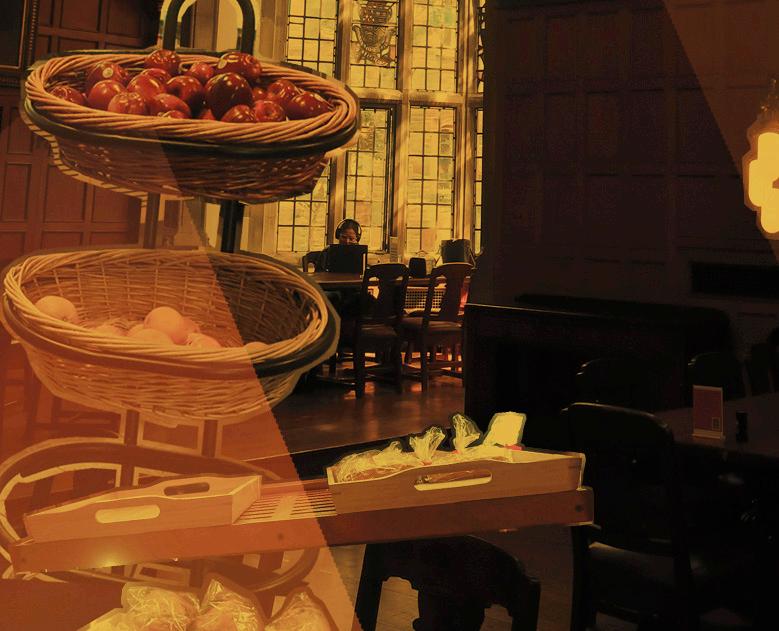
end of the year at U of T.
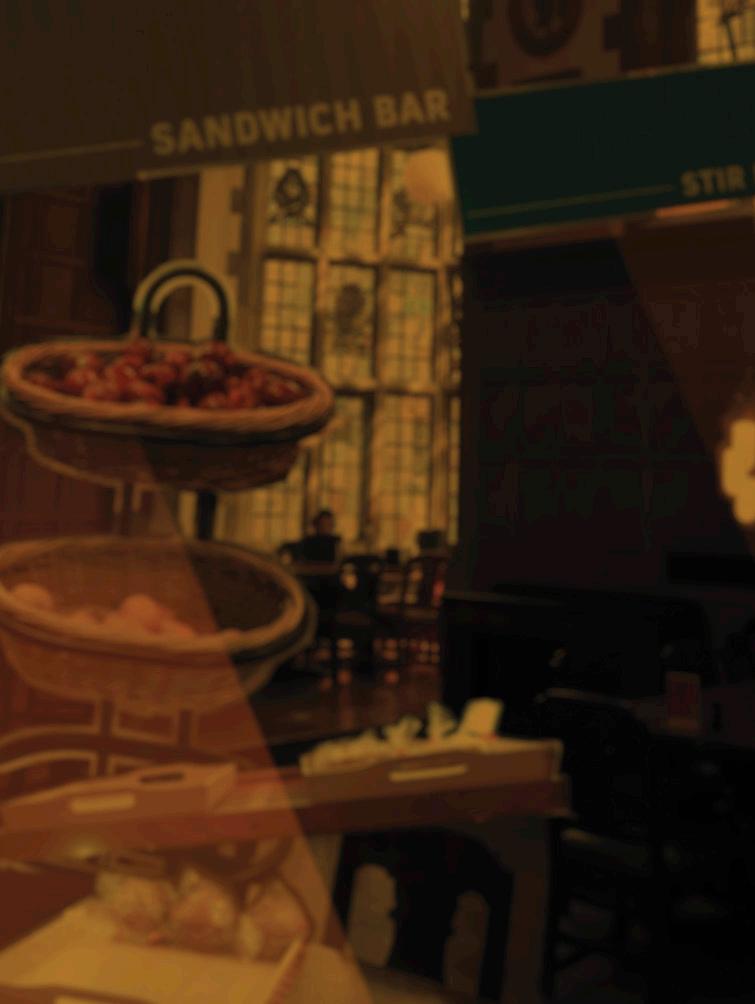
In response to the question “Is the meal plan worth it?” posed on r/UofT, one deleted user echoes students’ frustration at the lack of flexibility and consideration for variable eating habits. “What I dislike the most about the meal plan is I usually have 2 meals a day, but the meal
“Although I managed to spend the remaining funds turned into TBucks,” Rodríguez wrote in an email to The Varsity, “as an international student, the conversion into my country’s currency and the Canadian dollar would still get affected as the tax reduction of the meal plan is lower than [that] of the TBucks.” Students at UTSG and UTSC can use TBucks on their TCards to pay for food, textbooks, printing and photocopying on campus. “Thus, although I could still spend those funds on food, by the
surplus dollars at the end of the year. Yet none of the three campuses offer an adequate refund option.
Rigorous refund rules
UTSG allows unspent meal plan money to be transferred to Campus Flex Dollars that can be loaded onto TCards. Flex Dollars can only be used at specific locations, like Kelly Café, Robarts, and Café Reznikoff, and are only refundable if you withdraw from the university or have graduated. Additionally, money that is
converted into Flex Dollars and refunds both have a $50 administration fee, which will be deducted from a student’s remaining account balance. Any balance of $50 or less is ineligible for transfers and refunds. If your account is inactive for a year after leaving U of T, it will be automatically deactivated, and the money will be forfeited.
Students can also transfer Flex Funds to Carry Over for the following year.
Are meal plans worth it?
In a differing response to the r/UofT Reddit post I mentioned earlier, another student expressed that the financial aspect of the meal plan was fine, but that the actual food itself was more problematic.
have struggled to have well balanced meals. Thus, with the school’s meal plan, students have the option to take off the burden.”
Another r/UofT user commented that while the meal plan is “not bad,” it’s also “not worth it because the food isn’t good all the time,” so they wouldn’t recommend it. “I made a couple of friends on res[idence] and they all said the food wasn’t good all the time too… I live off campus now and I think it’s way better to get groceries than purchasing the meal plan, based on my experience.”
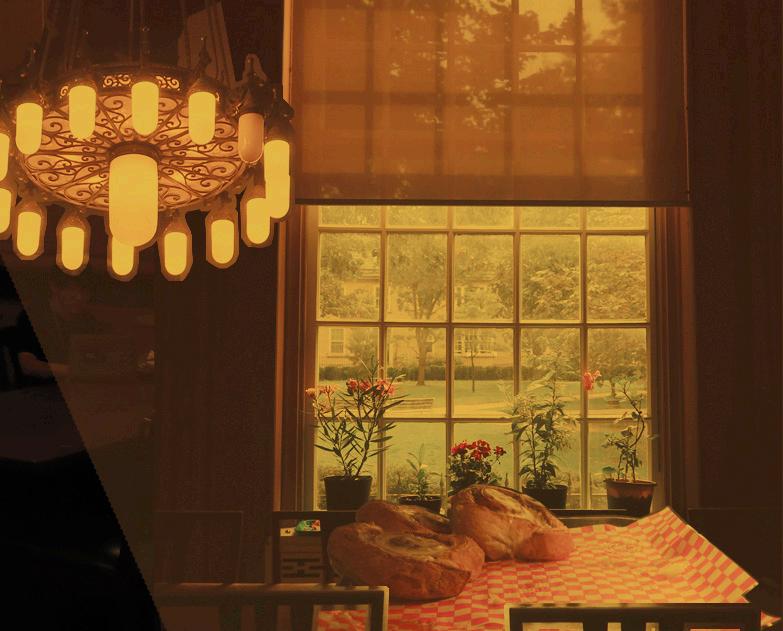
UTSC’s MyWay monthly Meal Plan dollars can be converted to TBucks, which are flexible dollars that can be used at UTSC and UTSG. If you have a regular meal plan, leftover money is non-refundable after the plan expires. It can also only be used at the Harmony Commons Dining Hall.
UTM’s minimum commitment for meal plans is $2,750. According to the Hospitality & Ancillary Services website, “Any Basic dollars remaining (over the Minimum Commitment) are eligible for Carry Over to the following year.”
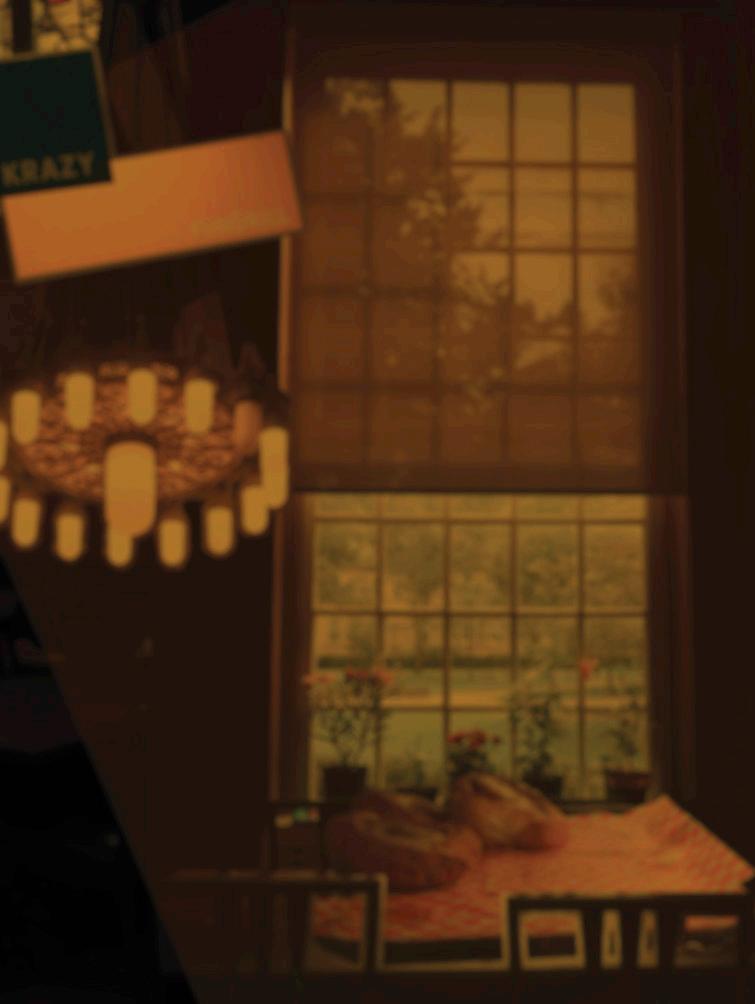
“Overall I do think it’s good to have, but I do believe if you have high standards for the food you’re eating (taste and health wise), meal plan is probably not as great as cooking for yourself.”
A more positive perspective considers the benefits that meal plans provide for first-year students. Anabelle Hsiao, a fifth-year computer science student, pointed out in an email to The Varsity, that most students who live on campus are first-years with limited independent living experience. “While needing to manage schoolwork, social, and a new environment, many
A mere difference in food or taste preference can be a determining factor in whether or not a meal plan is worth it for some students.
But for most students, including this commenter, that factor wasn’t considered. “I lived on res[idence] in my second year (in Trinity College), and the meal plan was mandatory, so I had no choice.”
There is no doubt that meal plans help students save time to cram in their last-minute studying while munching away. However, routinely having minimal food options can lead to the guilty daydreaming of DoorDash food that the dining hall lacks.
When calculating the total cost of meal plan fees on
top of all the financial expenses associated with studying at U of T, is food convenience truly worth the cost?
Making the most of cemented meal plan policies
Since U of T appears reluctant to make meaningful changes to their meal plan system, online and on campus alike, students must strategically navigate a meal plan system that doesn’t always work with them to help make the most of their money.
Initiatives like the Meal Plan Recycling Program and Free Food at UofT are doing just that, providing resources for students to ‘recycle’ their leftover meal plan money to “help purchase and distribute food to those in need,” and “combat food insecurity.” The Meal Plan Recycling Program organizes food drives and tabling events to donate food bought with students’ leftover meal plan money to Toronto Food Not Bombs, an “organization dedicated to providing food security and dignity,” according to their website. Free Food at U of T hosts free meal events and caters campus events with free snacks for students. For students who may be more familiar with r/ UofT, advice from upper-year students is equally as plentiful. When a student visited the popular subreddit to ask if they should buy a meal plan, other students came to their rescue with some helpful tips.
“I recommend against buying a meal plan until you’ve had a chance to figure out your eating habits,” one student commented. “No sense in getting the full year’s meal plan if you don’t end up using it.” They also suggested cooking meals at home because it is the most convenient, healthy, and cost-effective option. “Even if you don’t cook, getting a rotisserie chicken and making a salad is pretty easy and cheap.”
Another student highlighted that “There is a tax benefit to meal plans but you get so sick of the on campus options pretty fast. Buy a small amount if possible. I stayed in res[idence], which had compulsory meal dollars. Almost all of us had left over dollars at year end, which expires if we don’t use them, so we end up buying boxes and boxes of Gatorade or water bottles or chocolates.”
Rodríguez similarly recommended focusing on healthy eating habits and organization to offset the higher costs of the more inclusive meal plan options. “Build a meal plan for yourself that is healthy and reminds you to eat your complete meals. This will allow you to manage your expenses and even organize your schedule for any other activity. If you are planning to get any package of meal plan, combine it with self-made meals.”
Meal plan options reflect the good intentions of convenience for students. However, things like inflexible pricing options and required meal plans create a system that works against students and their wallets.
Although many students seem to agree that the meal plan system is flawed, they have learned to adapt through strategic budgeting, meal planning, and looking into helpful free food initiatives. With all the stress of assignments, exams, and jobs on our shoulders, mismanaged meal plan money is but another unfortunate burden for the hardworking students of U of T. But we are proactive in saving as much money and sharing as much food as can be bought with the typical few hundred dollars left over by April. The students of U of T are hopeful for a brighter future for the meal plans.
Arts & Culture
September 30, 2025
thevarsity.ca/category/arts-culture arts@thevarsity.ca
Interview with Andrea Werhun and Nicole Bazuin on Modern Whore (2025)
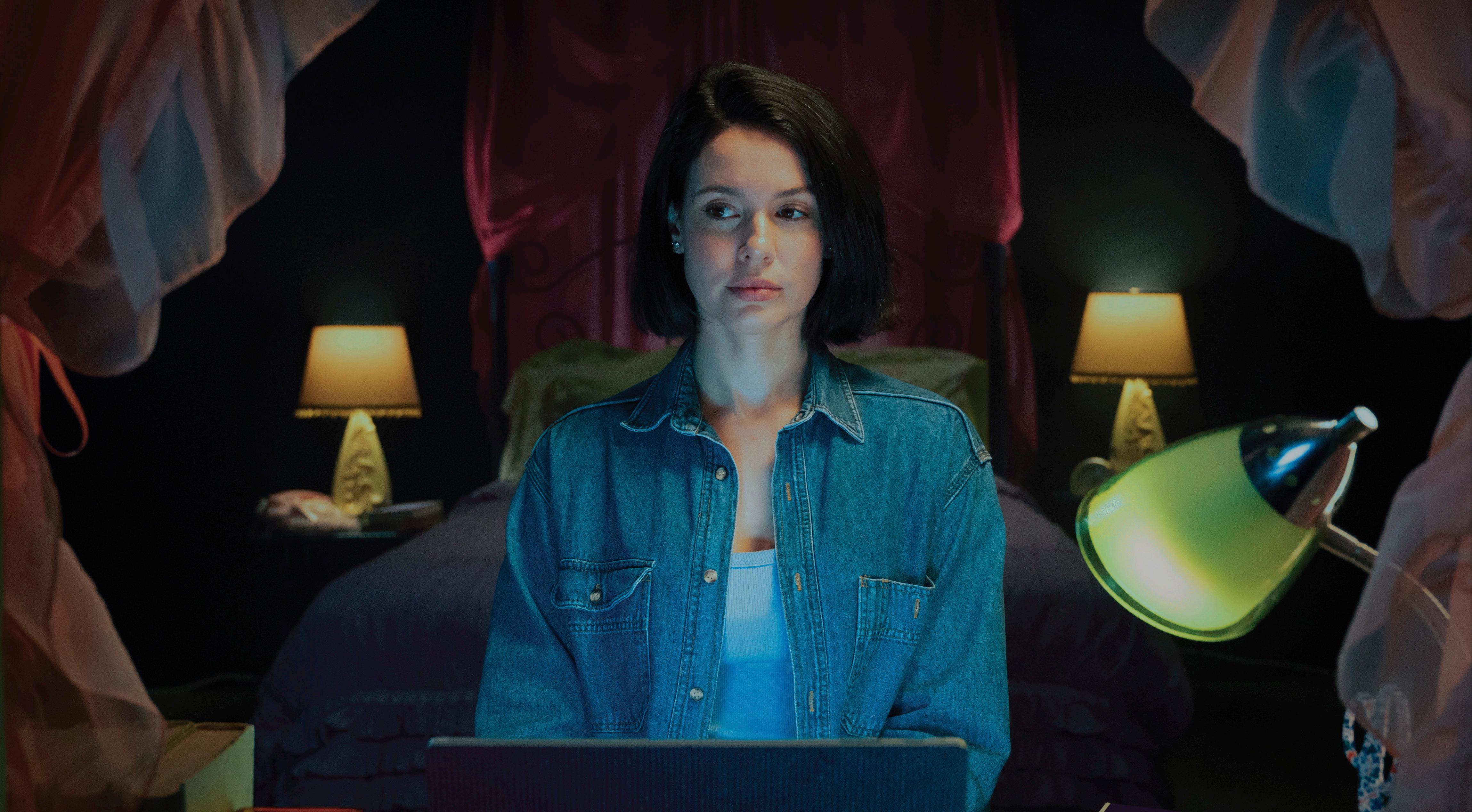
Directors dig deeper on their TIFF debut and the world of sex work and performance
Alex Docherty
Varsity Contributor
Soaked in style and honesty, Andrea Werhun and Nicole Bazuin tackle societal expectations of sex work in Modern Whore — a documentary film about Werhun’s experiences as an escort during her time at U of T and her subsequent relationship with sex work post-graduation. The 2025 documentary is preceded by a book (2017) and short film (2020) of the same name.
Werhun’s expertise has impacted the likes of Sean Baker’s Oscar-winning Anora, with Werhun acting as a sex work consultant for the film. Baker was also an executive producer of Modern Whore, which had its world premiere at the Toronto International Film Festival (TIFF) this year.
The film follows the charismatic Werhun, who tells her story with sincerity and wit. Werhun and Bazuin reclaim experiences of sexual assault and violence through a distinctively bright and humorous form — incorporating sketches, playful animations, and a striking title design.
I had the pleasure of seeing the film at TIFF and discussing the duo’s approach to storytelling, filmmaking, and sex work.
The Varsity: I’m curious about the aesthetic behind the film, if it served a specific purpose in telling your story?
Nicole Bazuin: The bright colours, the stylization, are meant to immerse you in the world of Andrea’s story. The idea is to create something that feels artful, but can also run the gamut of the stories Andrea tells. So we have the light and the dark.
Andrea Werhun: The brightness and colour stand in stark contrast to the ways that sex workers are typically depicted in film, which always feels almost universally dark, dingy, scary, and fearful. We wanted to create a sex worker narrative from a sex worker perspective that was bright and beautiful and sumptuous.
TV: Was this playfulness meant to cut through the darker and serious moments? You in boy drag, for example, is so funny.
AW: Shame Biscuit! Well, I’m glad that you like Shame, my little drag boy character. It’s my inner demon that represents the shame and stigma we experience as sex workers, this internalized voice of the power structures that be, that makes us feel like we’re totally unworthy of being loved and treated with respect.
I love playing him. He’s really important. Spin off when?
TV: You talk a lot about shame and whorephobia in this film, especially in hiding your profession from others or fighting internal biases. Does creating art about these feelings ease them?
AW: I definitely think that shame is the flipside to pride. And so, in order to access that other side of the spectrum, storytelling plays a really important role. I will say that art cannot be the only way that we deal with our trauma, but I do think that it’s a really important way to bring voice to the things that we’re supposed to be ashamed of. And I know for a fact that it also helps the viewer feel a lot less alone.
TV: You talk a lot about sex work as a performance. Whether it be stripping or OnlyFans, you’re performing for an audience. Do you feel like there are parallels between that and performing your story for a film audience?
AW: Yeah, for sure, and gender is a performance too. Being a woman is a performance. And obviously, being an actor is a performance, and being a sex worker is a performance. And all of these roles that we play engage in capitalism in order to financially survive — obviously, you have to perform a role to do that, right? No matter what that job is, whether it’s sex work or not. I think it was really important for us to play with that idea of sex work as performance in the film, in the performance of the performance.
TV: The interviews with your mom and your boyfriend were a highlight of the documentary for me. Outside of Lizzie Borden’s Working Girls, where we see the protagonist with her partner in a happy relationship, most other depictions of sex work in film tend to be solitary or result in a broken home. Can you speak more to that choice?
AW: That is exactly why it was important for us to demonstrate that: I am a singular sex worker who has strong, loving, long-term bonds with the people in my life, because the stereotype is that sex workers are these isolated caricatures of victimhood who have nobody.
That’s part of why we are seen by predators as easy prey. So it’s important to publicly proclaim our humanity through our living, loving relationships
with other people. Not only with my partner and with my mom, but also with my colleagues — my friends who are also my collaborators on various artistic projects that have to do with sex work.
It was really important to demonstrate that, yeah, we’re people in a community and we love each other and we support each other. And if you think you’re going to get away with harming us, you’re wrong.
Like, there are people who are going to be really, really pissed off if you try to hurt us. So, having someone like my mom in the film — I don't think that we’ve ever been allowed to even see sex workers on film in relation to their mothers in a positive way.
I think the viewer’s experience of seeing my relationship with my mom and the universality of the desire to be loved for being yourself goes beyond sex work.
TV: Obviously, this film is very personal, but sex work is not a monolith. Can you speak more on why it was crucial to platform and consult other sex workers?
AW: I think that’s where the feature film goes beyond the book and beyond the short films, it expands the universe of Modern Whore to include a variety and diversity of experiences to bring home that point that sex workers are not a monolith.
We do not all believe the same thing. We do not come to the work the same way. We don’t all feel the same way about our work. But we are all human beings, and we all deserve to be treated with kindness, respect, and to be granted the same equal rights as everybody else.
TV: I think this documentary is quite special in that you guys are both the subject and the filmmakers. I’m wondering if you have an opinion on filmmakers who have no firsthand experience with sex work, telling the stories of sex workers.
AW: Yeah, I got a couple opinions. [laughs all around]
I think that civilians should stop making work about sex work. Period. I think hiring consultants is the bare minimum, but consultants don’t have any decision-making power, so their opinions can be taken or left.
I think civilian filmmakers really need to look themselves in the mirror and ask themselves why they feel that they need to tell stories that are outside of their lived experience, instead of giving
opportunities to sex workers themselves to tell those stories.
It’s not to say that like every writer-director has to stay in their lane. I think it’s important to have imagination and to tell stories. But I think with sex work specifically, the problem is that 99.9 per cent of sex worker stories in popular culture, in TV and film, have been told by people who have never done the work themselves. And that is deeply problematic because it directly informs the way people perceive sex work.
TV: And it’s usually men, too. So they’re seeing it from their gaze, which completely subverts how sex workers present themselves versus how a man wants a sex worker to be presented.
AW: Precisely. And I think that what we witness then, especially in these stereotypes that are perpetuated about our constant victimhood and the inherent violence of sex work, without ever contextualizing where that violence comes from, which is from policy and from criminalization that makes it impossible for sex workers to rely on law enforcement without being arrested ourselves when we report crimes perpetrated against us.
We need to be able to put that into a very clear context instead of fetishizing the violence that’s perpetrated against us, that’s regurgitated as disturbing fantasy by men on screen.
Nicole is not a sex worker, she’s an ally. But, most of all, she’s my friend. Modern Whore is an expression of friendship and love. It is so deeply humanizing to be seen as an equal and a collaborator on something that is beautiful and sumptuous as well as political. I’m not just a consultant on this project; I’m a co-writer, producer, and actor, and I have a say in who gets hired onto this project and who makes me feel safe on-set. All of these factors make the film feel like a sex worker-driven depiction of sex work. Nicole is the absolute best, and I hope that other allies hire other sex workers to be executive producers on their films. That way, that sex worker can get a backend on that film and financially benefit from a depiction of sex work in the film. We need sex workers to have decisionmaking roles in films that involve sex work.
This interview has been edited for length and clarity.
TIFF review: The Merlion is fucking huge Siyou Tan’s
debut feature Amoeba screens at TIFF
Nora Zolfaghari Senior Copy Editor
Director Siyou Tan’s debut feature film, Amoeba, follows teenage Choo Xin-Yu (Ranice Tay) in her last year before secondary school. She finds quick friends in a group of restless girls, Sofia Teh (Lim Shi-An), whose name is misspelled as “Tay” on her uniform nametag; Vanessa Ooi (Nicole Lee Wen), who is apprehensively bound for swimming greatness; and Gina Wong (Genevieve Tan), who remains the gang’s rock.
The film opens with Choo being haunted by a ghost in her room. This could be the ghost of many things: school, the ever impending doom of aging, friends, work, exams, you name it. The
and ‘authoritarian’ Singaporean education system that Tan wanted to capture in the film. To appease their rebellious spirit, their Uncle Phoon (Jack Kao) helps them form a gang –– a real one; a pact of friendship and brotherhood, with the loyalty and earnestness of any real, life-changing middle school friend group. Calling each other “brother” rather than “sister” made the girls feel like they had more agency, as in Tan’s family ––which I suppose is the patriarchal world standard –– they had a fatherly lineage.
To capture the gang’s closeness and their personal riot for self-rule, many of its escapades are filmed by a camcorder — rather than being filmed by an outsider camera crew — held by the cast themselves.
Through the camcorder, we came to understand many of the dynamics in the film. When Choo is initially accepted into the friend group, their first act of initiation is getting a cameo on the camcorder. Though it belongs to Sofia’s brother, Sofia lets Choo keep it since she sees how much she enjoys recording, solidifying their friendship.
The gang record themselves singing a song from the movie 15, which stars real Singaporean gangsters. The principal uses this as evidence to try to get them expelled for being in a gang, an accusation that obviously, they all deny. At the end of the day, they’re kids, they still have to get into a secondary school, and they can’t have suspensions on their records.
Choo awake throughout the night. Choo’s exhaustion invigorates her already adversarial character, but when Vanessa comes over to help her catch it with the camcorder, that’s when Choo’s feelings towards her develop –– confusingly and intensely.
Amoeba feels like Tan’s olive branch to young girls with a temper. My genuine disdain for the man sitting next to me in the theatre was validated. Ultimately, it wasn’t anger towards him specifically, it was about the broader fact that, once again, the self-absorbed ignorance of others ––or that’s just what it feels like, I suppose –– had thwarted my relaxed freedom to enjoy the world.
When asked what the title of Amoeba means for each of the cast members after the film screening, Ranice Tay replied that “Amoeba is the size of rebellion that exists in each of us, that we should never forget, that refuses to get named or labelled and that makes us thrive.”
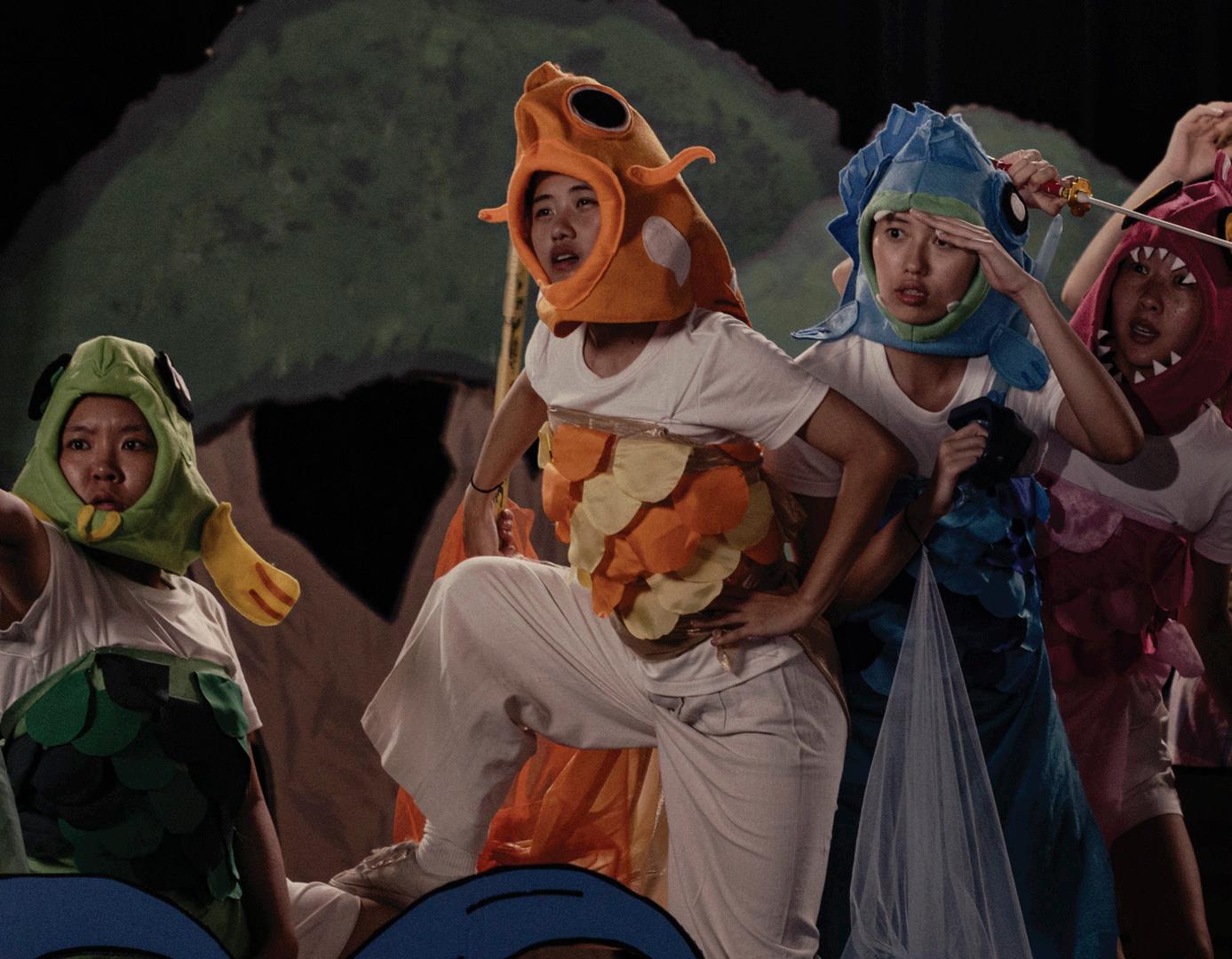
You revolt, you hide out in caves and run around the city, you don’t study, you get reprimanded, which only makes you want to rebel more. The Ouroboros of youth, if you will. But that’s the point of the whole thing, Tan argues. Tan decided to remove the ending of the film, in which we learn where the gang ends up in a couple of years’ time. The audience is left without catharsis, we don’t know how the gang does on their final exams, we don’t know if they continue to be friends, or if they end up going to the same secondary school.
Near the end of the film, Choo finds Uncle Phoon’s shrine, a table full of his friends sitting nearby. They usher her over, telling her about Uncle Phoon’s life. He too was in a gang –– a real one –– working as a driver for Sofia’s dad, making the two like a real family.
Phoon’s friends reminisced about their life together, their closeness despite the fact that they spent many years apart. Even the gangsters from 15 are now married with children, working regular jobs, and have only met up once since filming, though it was slightly awkward.
But Sofia has money, Vanessa has swimming, Gina has her uncanny ability to pull through at the last moment, and Choo has her ghost.
scene is completely silent except for the droning of a fan keeping Choo’s room cool.
The man beside me in the theatre, however, thought this would be a good time to systematically shove popcorn in his mouth with the vigour of a starving savannah animal. While he gnawed with his mouth fully agape, I flashed him a couple of dirty looks, which he didn’t see as he was too distracted by his pail of greed. Had I been five years younger, though, maybe I would’ve really said something.
Choo and her friends are contrarians, which doesn’t bode well for the incredibly competitive
Scenes like the one where each member of the gang shows off their most “confusing talent,” including fighting, skateboarding, and general athleticism, allowed the cast to film on the camcorder amongst themselves, without Tan’s oversight. Tan and the cast were sitting in the row in front of me in the theatre, and when this scene played, they laughed just as hard as the rest of the room, and afterwards they reminisced about how it was their favourite scene to film. For Tan, the most important part of the casting for the film was to ensure that the actors could “believably be a friend group.”
Contrasting the naturalistic filming medium, Amoeba is riddled with surrealist and supernatural elements that make the experience more dreamlike and absurd –– that is growing up, after all, I comment cheekily. The natural and the absurd work together to bring the gang together and tear them apart; they sit together in a candle-lit cave underneath their school, lined with artifacts they don’t understand the value of, but Sofia’s room has AC and a balcony while Choo only has her –– very loud –– fan.
Although we can’t see it, the ghost moves furniture around and pulls on the bedding, keeping
Finding yourself isn’t lonely, Tan assures her audience. An amoeba’s power comes from its “shapeshifting blobiness.” You, reading this, are likely in university, planning the future ahead, doing your last bit of growing up. Even though it feels so special, it feels special to everyone; everything you do during these times is along the lines of finding treasure in a cave with your gang of brothers.
And what you take away from that may not always be what you expected, as someone leaving the theatre proclaimed about the movie, “I did learn a lot about the Merlion, though.”
September 30, 2025
thevarsity.ca/category/science science@thevarsity.ca
TIFF Review: Arco : On time travel and rainbows
Witness the future of the climate crisis in full, animated, colour

Medha Surajpal Editor-in-Chief
From first-time attendees to veteran viewers who clap during TIFF’s Varda café-bar ad, this year’s Toronto International Film Festival (TIFF) lineup had something for everyone.
I was lucky enough to snag a ticket to Arco for the film’s North American premiere. The film was screened in English, but it is a French animated sci-fi film directed by Ugo Bienvenu, starring the voices of Natalie Portman, Mark Ruffalo, America Ferrera, Will Ferrell, and Andy Samberg.
Arco is a colourful reimagination of time travel, playing off the idea that every rainbow represents a time traveller from a distant future.
The premise
It is the year 3000, and our protagonist, Arco, is a 10-year-old boy who lives with his family in a floating home in the clouds, where humans have gone to live to give the earth a break from the overuse of its resources.
Arco’s family works to bring back extinct flora by travelling back in time to procure live samples to plant and repopulate their self-sufficient home garden with. Using multi-coloured capes and a special light-refracting crystal embedded in its hood, they are able to literally soar through the sky, leaving rainbow arcs behind them.
The capes let them use rainbows to fly to any time of their choosing — similar to how hyperspace works in Star Wars — but instead of reaching new locations, they travel to entirely different eras. It felt like the capes turned them into casual heroes, though flying and timetravelling still come with their own rules.
All Arco wants to do is see dinosaurs, but children under 12 are not allowed to timetravel. He is jealous of his sister’s adventures,
especially since she’s only a few years older than he is. One night, Arco steals his sister’s rainbow cape and crystal, and jumps off the ledge of his home, hoping to use the rising sun’s light to fly.
With no training, however, he just barely takes flight long enough to crash land in the year 2075, in the forest behind the school of a girl named Iris.
Iris and her nannybot, Mikki
Iris is about Arco’s age, and in her time, humans were still living on Earth. Every building in her city is equipped with bubbles that block out all extreme weather — which is necessary for the amount of rainstorms and wildfires they experience as a result of increasing temperatures and a depleted ozone layer.
In 2075, robots have replaced human teachers, construction workers, police officers, and even caretakers. Iris and her baby brother Peter are home alone most days with Mikki, their nanny bot, as their parents work in the city and only return on weekends, if at all.
As the kids celebrate a parent’s birthday while the parents attend as holograms, Iris is visibly disappointed that her mother wouldn’t even leave work for a special occasion. Mikki is a replacement parent in every sense, but the physical absence of Iris’ parents leads to her feeling alone and distracted at school the next day. She makes an excuse to get out of class, which is when she finds Arco after his crash.
2075 is not an absurdly far time from where we are now. Arco introduces the reliance on technology in Iris’s world from the second we see her character on screen. During Iris and Peter’s bathtime, we hear a voice imitating various characters behind the shower curtain at the children’s request, as a parent might do to entertain two small children. When the
curtain draws back, we see that it was Mikki the whole time. The robot even speaks using a mechanical blend of Iris’ parents’ voices.
The children’s relationship with Mikki reminds me of the reliance many of us have on chatbots and AI today. It seems that as a caretaking robot, Mikki’s primary goals are to keep the children safe, fed, and aware that their parents still love them. If an algorithm can think for you, why wouldn’t you take advantage of that?
When Iris asks Mikki about why her parents didn’t come home, the robot reassures Iris that the hologram robot she calls her parents on nightly was always near. If it seems absurd that a robot could aim to make a child feel better, have you ever heard of ChatGPT therapy? 2075’s tech might not be so far off.
The technology in Iris’s world is embedded in every part of their day-to-day life. Even her classroom is a 360-degree immersive screen showing today’s lesson topic, complete with teacher robots. Moreover, the name of every citizen is stored in a shared database for robots to access, which is not too dissimilar from our current reality, with its ubiquitous face recognition software and information databases. In fact, because of this, the two children crash Mikki’s software by sharing Arco’s name, which doesn’t yet exist in the android’s database, and Mikki is picked up by insurance bots for testing. It’s unsettling how much surveillance is possible by having robots in every home.
The climate crisis from a child’s perspective Arco is told mainly through the dialogue of young children, with the occasional input from humanoid robots and bumbling adults — time travel conspiracists that the kids brush off anyway.
While they are just kids, the film does an amazing job of showing the danger of letting the earth suffer at our hands while also showcasing how mundane these extreme weather events have become. The rousing score and clean, vibrant imagery take a sharp turn as a wildfire takes over the town. Until that point in the film, everything was light and pleasant. The shock of a blazing fire was a bit of a reality check for me as I watched the movie.
Canada’s National Wildland Fire Situation Report lists a whopping 8.8 million hectares of fire this year, which is more than double the 10year average. Every data centre needs cooling towers, and every cooling tower needs water, not to mention. According to an article published in July by Communications of the Association for Computing Machinery, global AI water use is projected to hit 4.2–6.6 billion cubic metres by 2027.
The humans in 2075 allocate insanely effective technology to protect their buildings, but no apparent infrastructure protects their forests or their planet. Arco briefly mentions a huge climate event that pushed all humans to move to the sky, something so severe that they had no choice but to give the earth a break, possibly due to the overuse of their technology.
Without spoiling too much of the plot for those of you who will be patiently waiting for the unannounced Netflix release date, Arco is a magical film for all ages. I was absolutely expecting a heartwarming story of friendship between Iris and Arco, but it was much more than that, addressing climate and privacy concerns that are highly relevant today.
The climate commentary, the physics of time travel, and of course, the stunning animation and score made it a must-see for me. I’ve loved science fiction for as long as I can remember, and Arco was a very welcome addition to my favourite genre.
Adventures in disrupted sleep Lucid
dreaming, sleep paralysis demons, and more
Ridhi Balani Science Editor
As the semester progresses and professors conspire to have every midterm and assignment due in the same two weeks, many of us end up ignoring sleep or adopting cursed sleep schedules. This isn’t an article warning you against losing sleep — sometimes life’s just like that. Instead, here are some adventures that can come your way with disrupted sleep.
But first, the basics of sleep
One third of our entire lives is spent asleep, which is a ridiculously high amount of time just being unconscious if you ask me. So what even is the point of sleep?
There is no direct answer for this question yet. What we do know are various factoids that create a picture of what happens during sleep.
Sleep is an altered state of consciousness that cycles through four stages four to six times a night, with a whole cycle lasting about 100–800 minutes. The first three stages are called nonrapid eye movement (non-REM) sleep, which includes the transition between being awake and asleep, being fully asleep, and finally, deep sleep.
The fourth stage is REM sleep, when brain activity spikes or becomes about as active as when we are awake; this is when dreaming happens. Your muscles are also limp at this stage, so you don’t actually act out your dreams.
Sleep is thought to be critical for growth, repair, recovery, and memory consolidation, so it is understandable that a chronic lack of sleep has been associated with health disorders affecting the immune function, cognition, metabolic, and even cardiovascular diseases.
We also know that without sleep, our motor functions decline, our cognitive abilities slow, and in some cases, we will die.
Those are all the more serious complications of sleep deprivation that we’ve all been told about, but they seem fairly unlikely when you’re regularly sleep deprived.
Some of the more interesting — or terrifying — things that can potentially happen on a more immediate basis include fun things like encountering sleep paralysis demons, trippy lucid dreams, and just straight-up hallucinations — not speaking from personal experience or anything.
The demons that be Inadequate sleep or an irregular sleep schedule, among other causes, has been associated with the appearance of sleep paralysis demons. Sleep paralysis is essentially when you are awake but unable to move. This occurs when you wake up during the REM stage of sleep. So, sometimes you can just see figures approaching from the corner of your eye as you remain unable to move.
These sleep paralysis hallucinations can be anywhere from visual, auditory, to tactile, which can be fairly terrifying when you believe you are facing a demon. But rest assured, sleep paralysis demons pose no real danger, though it probably does not help anxiety symptoms for some. Either way, it is certainly a super fun way to wake up!
Why does that lamp look weird?
On a similar line, there are lucid dreams. This is when you become aware of the fact that you are dreaming. Instances of lucid dreams have been recorded for centuries and even scientifically confirmed in the ’70s–’80s through experiments where a subject moves their eyes in a particular
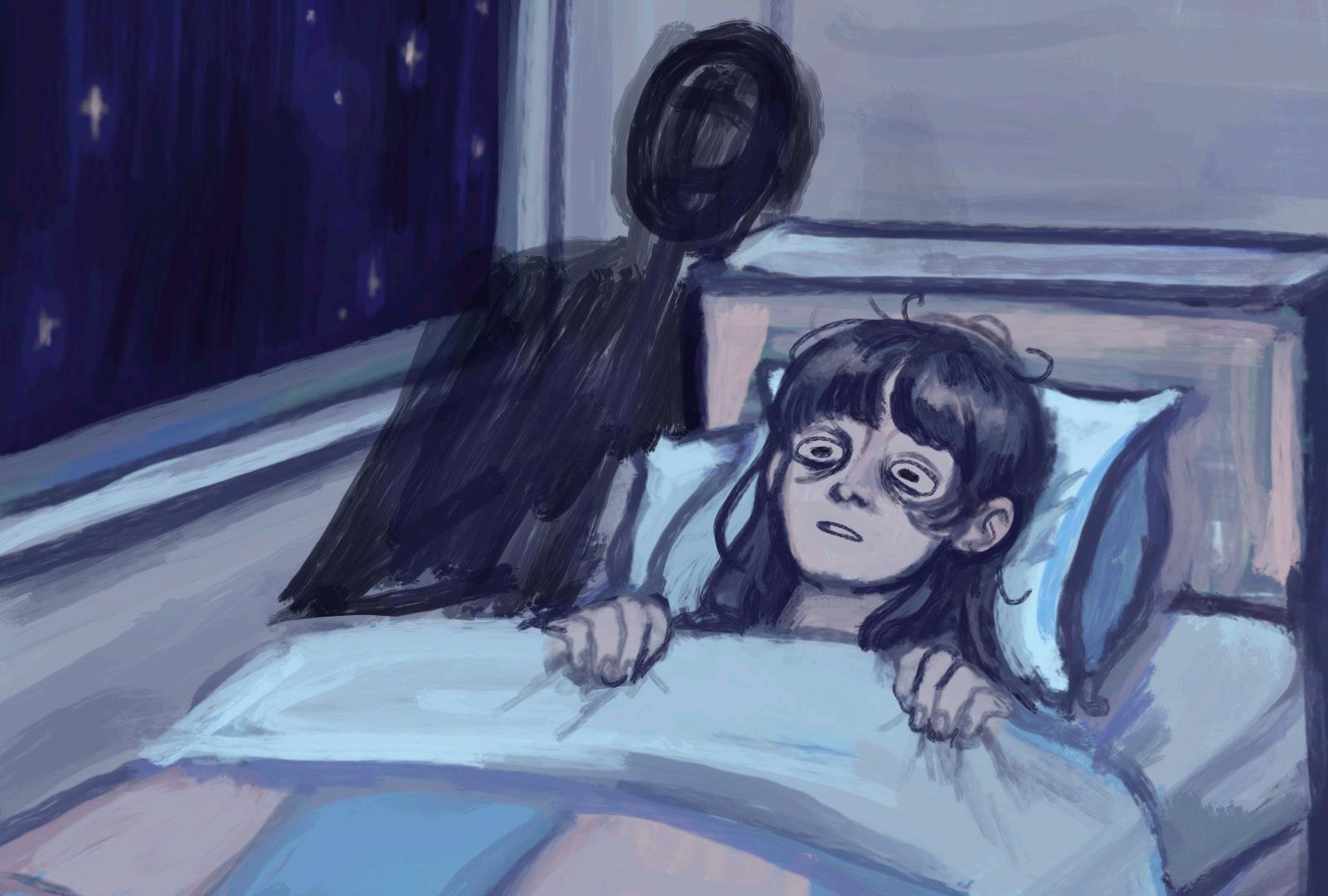
pre-established sequence once they gain awareness of their dreams. For example, some people may notice that the furniture in a dream location that matches reality looks like it was rearranged.
There are many accounts about ways to reach this stage, but if you have a disturbed sleep schedule, it may just reach you whether you want it or not. In fact, lucid dreaming has been somewhat associated with highly fragmented sleep patterns, which can occur if you take 20-minute naps with the lights on as you attempt an all-nighter — or so I’ve been told.
Do you guys hear voices, or is that just me?
Both sleep paralysis and lucid dreaming are related to when you actually sleep, but let’s take the no-sleeping route next.
On this path, many physiological things can happen. In fact, prolonged sleep deprivation is labelled as torture. Symptoms like delusions and hallucinations develop more and more with time awake until they devolve into full-blown acute psychosis. Though once you sleep, this is usually resolved.
While awake, though, even the beginning stages can be fairly trippy. For instance, people have told me they experienced bugs off the corners of their eyes, voices having a conversation in an empty room, or silhouettes following them.
So, while those late nights at Robarts or nocturnal study habits may feel a bit inevitable, keep in mind that they may also come with some free — and sometimes terrifying — experiences featuring shadowy figures and rearranged dream furniture. So, enjoy your adventure if you choose to accept it.
SpineFEST 2025: Spotlight on spine care research
Modelling patient prognosis after metastatic spine surgery
Zuhal Olomi Varsity Contributor
On June 9, clinicians, research trainees, and physician-scientists came together to present research and findings in the field of spine surgery at SpineFEST 2025. Hosted by the U of T Spine Program — a program within U of T’s Department of Spine Surgery — the event brought together leading experts and researchers in the field of spine surgery to the forefront.
The event was opened by Dr. Michael Fehlings, the Co-Director of the U of T Spine Program, Head of the Spinal Program at Toronto Western, and Professor of Neurosurgery. U of T Neurosurgery Resident Dr. Husain Shakil presented an abstract on spine metastases at the conference, titled Home Time and Survival after Surgery for Spinal Metastases: Development and Validation of the Home Time and Overall Survival after Metastatic Spine Surgery Estimator (HOME Score).
Spine metastasis — or spinal metastatic cancer — is a type of spine tumour that occurs when cancer spreads to the spine from elsewhere in the body. It poses significant challenges for treatment and quality of life for the patient.
Dr. Shakil’s presentation spoke about the clinical prediction model he and his team developed to estimate both home time and survival likelihood after spinal metastases surgery.
Predicting patient prognosis — HOME Score
There is a lot of ambiguity on patient outcomes after metastatic surgery, as prognoses tend to fall on a wide spectrum. Some patients may recover well and return home quickly, while others may face significant complications,
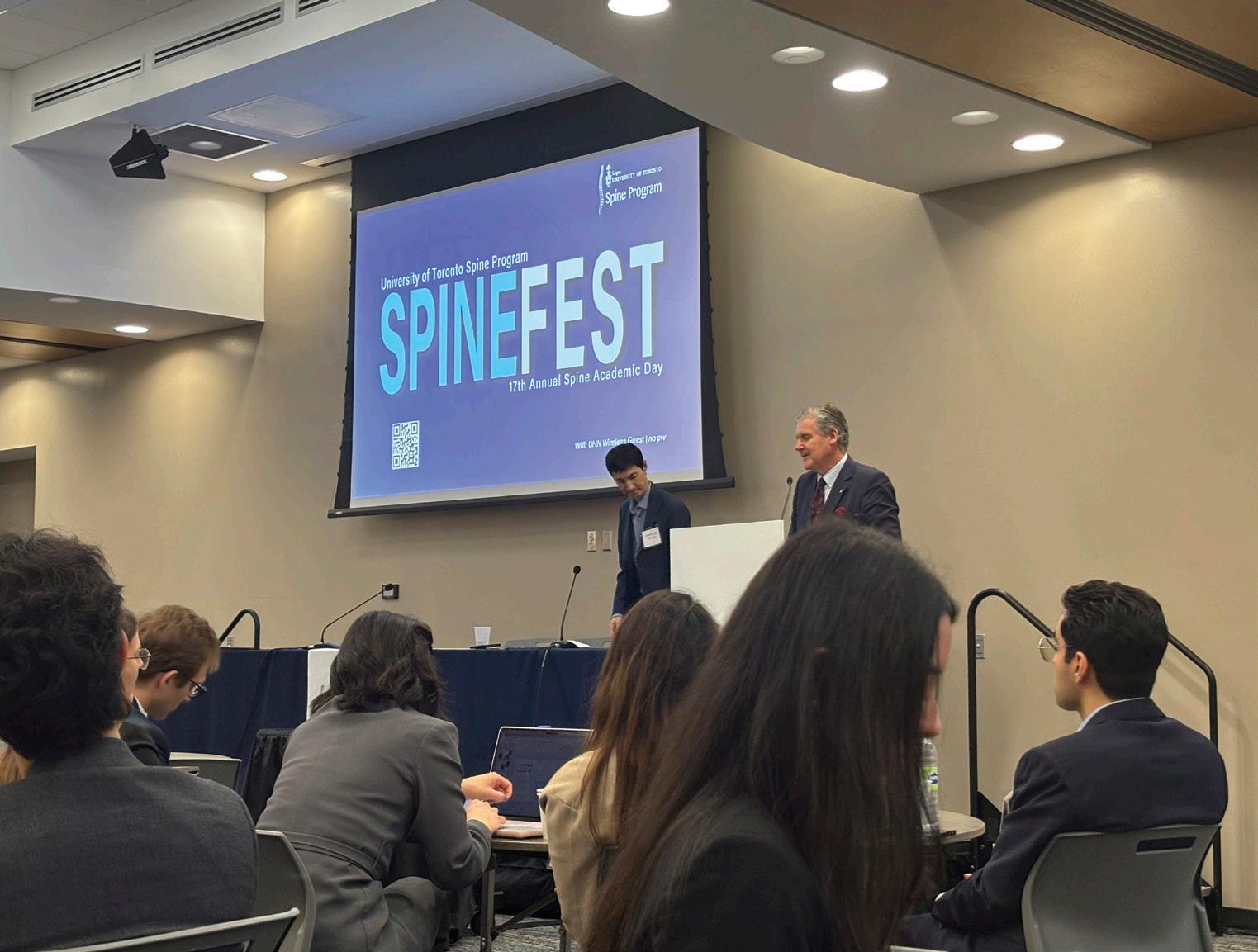
limited mobility, or shortened survival times. This unpredictability makes it difficult for physicians to guide treatment decisions, and for patients and families to prepare for what lies ahead.
Determining whether patients should undergo metastatic spine surgery is challenging because outcomes can vary widely depending on tumour type, overall health, and expected recovery. This uncertainty often leads to differing opinions between surgeons and primary care providers, leaving patients confused and burdened with difficult decisions.
Dr. Shakil and his team developed a novel clinical prediction model that has the potential to improve decision-making — weighing the risks, benefits, and likely recovery after
metastasis surgery. The HOME model, or the Home time and Overall survival after Metastatic spine surgery Estimator model, was the focus of the abstract. The HOME model predicts whether patients with spinal metastases are likely to benefit from surgery based on 17 items that predict home time and 24 items for survival, such as demographics, comorbidities — the presence of other diseases — and presentation of the cancer.
The data from the model will serve as a tool for physicians to support more accurate and efficient patient management decisions, ultimately reducing wait times in trauma centers, optimizing surgical resource use, and ensuring patients receive care more quickly.
Understanding the HOME Score
Researchers conducted a population-based cohort study — a specific category of epidemiology studies that follows a defined group of people over time to examine links between exposures and outcomes. It was conducted in Ontario, Canada, and included 2,348 adult patients who underwent metastatic spine surgery for tumours that had spread, or metastasized, from cancer elsewhere in the body between 2005–2020.
Patient data was divided into two cohorts: a training cohort of people who had surgery from 2005–2018 whose experiences were used to develop the HOME model, and data from people who had surgery from 2019–2020, which was used to assess how well the model performs on more recent patients. These two cohorts ensured the model’s predictions remained accurate and relevant.
In this study, the results confirmed that the HOME model could reliably identify patients most likely to benefit from surgery for metastatic spine disease.
The model focused on predicting two key outcomes: whether patients would spend three months or less at home following surgery — referred to as “home time” — and their overall survival at six months, one year, and one and a half years post-surgery.
Lung and breast cancers were the most common primary malignancies which then spread to the spine. The final model achieved reliable estimations of home time and survival, marking significant advancements in preoperative risk stratification — the process of evaluating a patient’s health before surgery to predict their likelihood of developing complications or experiencing adverse outcomes such as death or infection.
Dr. Shakil’s work demonstrates how computational modelling can be harnessed to support clinical decision-making in complex surgical settings. The HOME model offers a promising tool to enhance patient care while addressing broader system-level challenges related to triage and resource allocation in spine oncology.
Sports
Blue Jays fly high towards the postseason
September 30, 2025
thevarsity.ca/section/sports sports@thevarsity.ca
The Blue Jays wrap up September, punching their ticket for the postseason with a division title
Ashley Thorpe Varsity Board Member
At the end of the 2025 MLB season, the Toronto Blue Jays have emerged as one of the league’s biggest surprises this year. After a last-place finish in 2024, they soared to first place in the competitive AL East in 2025, managing to set a franchise record for most wins before the AllStar break and maintaining their first-place rank ever since.
Their dominance stems from a sharp increase in contact rate at the plate and their ability to limit strikeouts. The Jays rank first in MLB with only 1,099 strikeouts and lead the league in total hits with an impressive 1,461. After their success, expectations have shifted drastically.
Opening the year with a projected win total of 78.5, the Blue Jays now have a win total of 94 going into the postseason. After clinching the AL East division on September 28, the team has a first-round bye. This allows them to skip the wildcard round of playoffs to go straight to the divisional series. With a lot of depth and talent, the Jays are ready to continue making a serious, competitive playoff run.
The Blue Jays’ success this season has not come solely from their stars at the top of the lineup. In fact, much of their momentum has come from production at the bottom of the order. Vladimir Guerrero Jr. only has 23 home runs this season, which is much lower than other franchise players around the league. Anthony Santander, one of the most exciting new additions from the off-season, has spent the majority of the season injured and underperforming.
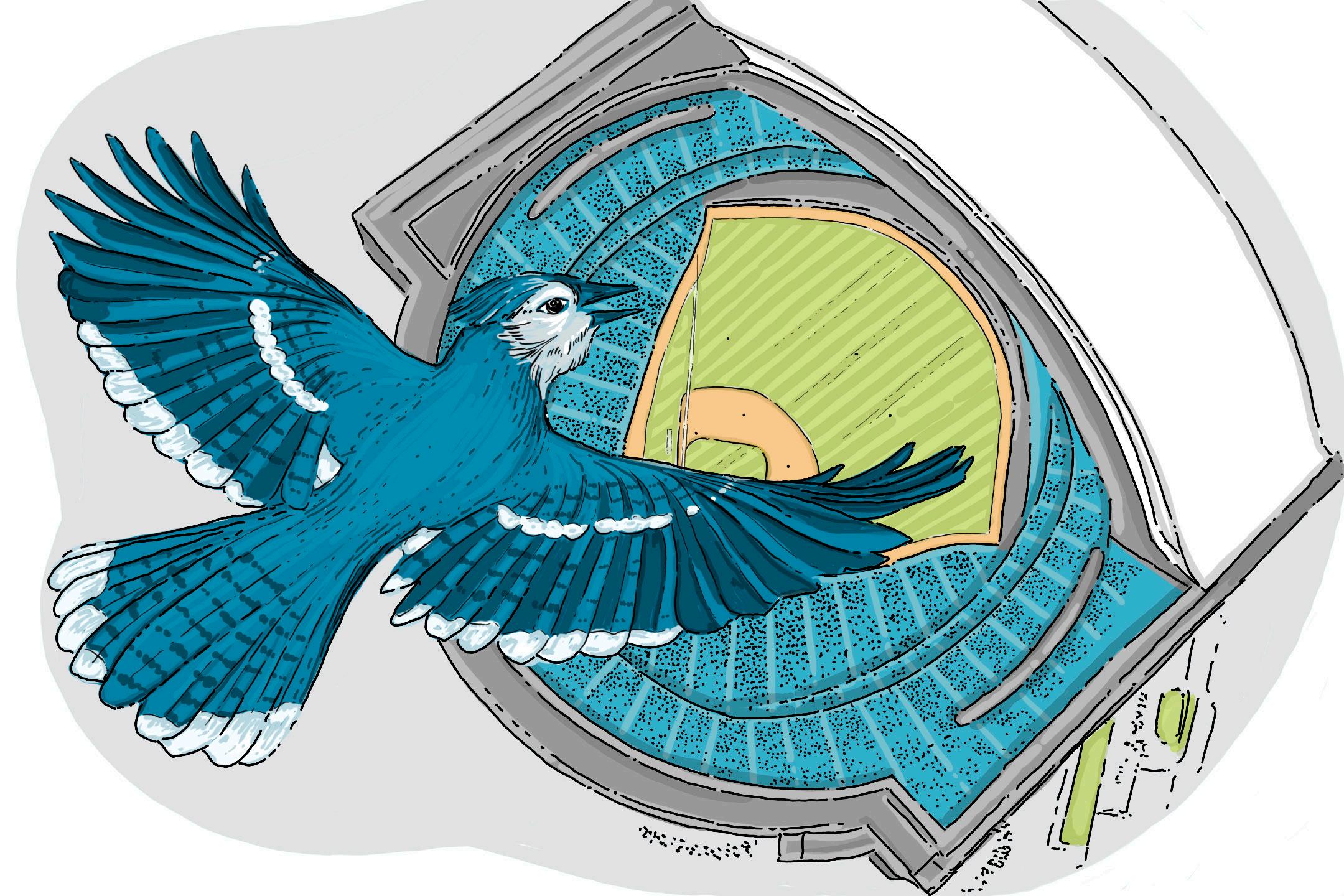
Despite this, players such as Andrés Giménez, Myles Straw, Ernie Clement, and Davis Schneider have shown up and consistently made contact at the plate. When the top of the order is not meeting expectations, the bottom of the order needs to propel the team through hard times. This is something that separates the Blue Jays from their opponents. The team is able to support one another, which creates a lineup with a lot of depth that is capable of responding to adversity better than many other teams around the league.
Throughout the season, there have been some question marks surrounding the Blue Jays’ pitching staff. Veteran right-hander Max Scherzer has successfully recovered from a lingering thumb injury and has been solid ever since. His ability to stay healthy and eat innings has been a major asset for the team during the second half of the season. Taking a gamble on Shane Bieber has proven to be worthwhile as well. The former Cy Young winner had Tommy John surgery in 2024 and was traded to Toronto from
Blues fall to Lancers following rocky first quarter
Rookie Tom
Hardie
records first career touchdown with Blues
Caroline Ho Sports Editor
The Blues faced off against the Windsor Lancers on September 20 at Varsity Stadium, looking to redeem themselves following three consecutive losses against the Waterloo Warriors, the York Lions, and the Queen’s Gaels, respectively. The Blues last played the Lancers on September 28, 2024, where they lost 5–52. Despite their best efforts, the Blues fell to Windsor once more with a final score of 14–34.
What happened?
The Blues were off to a rocky start as the Lancers scored off a rush on their first possession just under five minutes into the first quarter, giving them a 7–0 lead. The Lancers then scored a rouge point on the ensuing kickoff and further lengthened their lead with a field goal, bringing the score to 11–0. The Blues looked to gain traction, but the Lancers’ defence stayed strong, keeping the Blues scoreless into the second quarter.
The Lancers built on their lead in the second quarter with another touchdown, bringing the score to
18–0. While the Blues’ offence continued to struggle to make up ground, the Lancers proceeded to keep their momentum and scored a safety to gain a 20–0 lead.
With 2:17 minutes remaining in the quarter, the Blues were finally able to crack through and get on the board. Rookie receiver Tom Hardie scored his first career touchdown on a 71-yard pass from a trick play by kicker Sam Henke. Henke then scored a rouge point and then tallied another three points for the Blues with a field goal at the end of the first half, closing the score gap to 20–11.
The third quarter remained deadlocked for just over nine minutes, with both teams making attempts but ultimately failing to capitalize. Finally, Henke, again instrumental to the Blues’ point tally, scored another field goal to bring the score to 14–20 to add to the Blues’ comeback. However, the Lancers extended their lead with another touchdown in the final minute, and the teams went into the final quarter with the score at 14–27.
The Lancers scored a field goal less than five minutes into the fourth quarter, widening their
Cleveland while still in rehab. Since his return to the big leagues, Bieber has had a respectable 3.57 earned run average (ERA) and 37 strikeouts across seven starts.
However, the bullpen has been plagued by injuries. Yimi García and Nick Sandlin, who were key pieces of the bullpen, are injured and will not be able to return to the team in time for a postseason appearance. Fortunately, José Berríos has been moved to the bullpen, helping to stabilize the rotation and provide much-needed support. These additions and adjustments have set the pitching staff up to be quite threatening in playoff games.
The last time postseason baseball was played in Toronto, the Blue Jays blew an 8–1 lead against the Seattle Mariners, eliminating the Jays in only the first round. A year later, the Blue Jays were swept again in the first round, this time by the Minnesota Twins. Last year, they missed the postseason entirely, earning nothing but a last-place finish. Toronto baseball fans haven’t felt the excitement
of winning a playoff game since 2016. Nine years later, the Blue Jays are long overdue for a deep run on the road to the World Series. Newfound depth in both the hitting and pitching lineups positions the team as a strong competitor in the American League.
A packed Rogers Centre has helped fuel the team’s momentum. An impressive 54–27 record at the Rogers Centre this year proves the importance of passionate fans in creating a home-field advantage that has fuelled the Blue Jays’ success. The energy from the crowd was electric, giving the team a boost in morale as they clinched their first division title since 2015.
If the Blue Jays can return to their previous level of success, capitalize on the shortcomings of division rivals, and keep the wins coming, the team could turn an exceptional first half into a historic season. If all goes right, it could only be a matter of time before fans are hearing, “Guerrero Jr. with a drive. Deep left field. No doubt about it!” echoing into October.
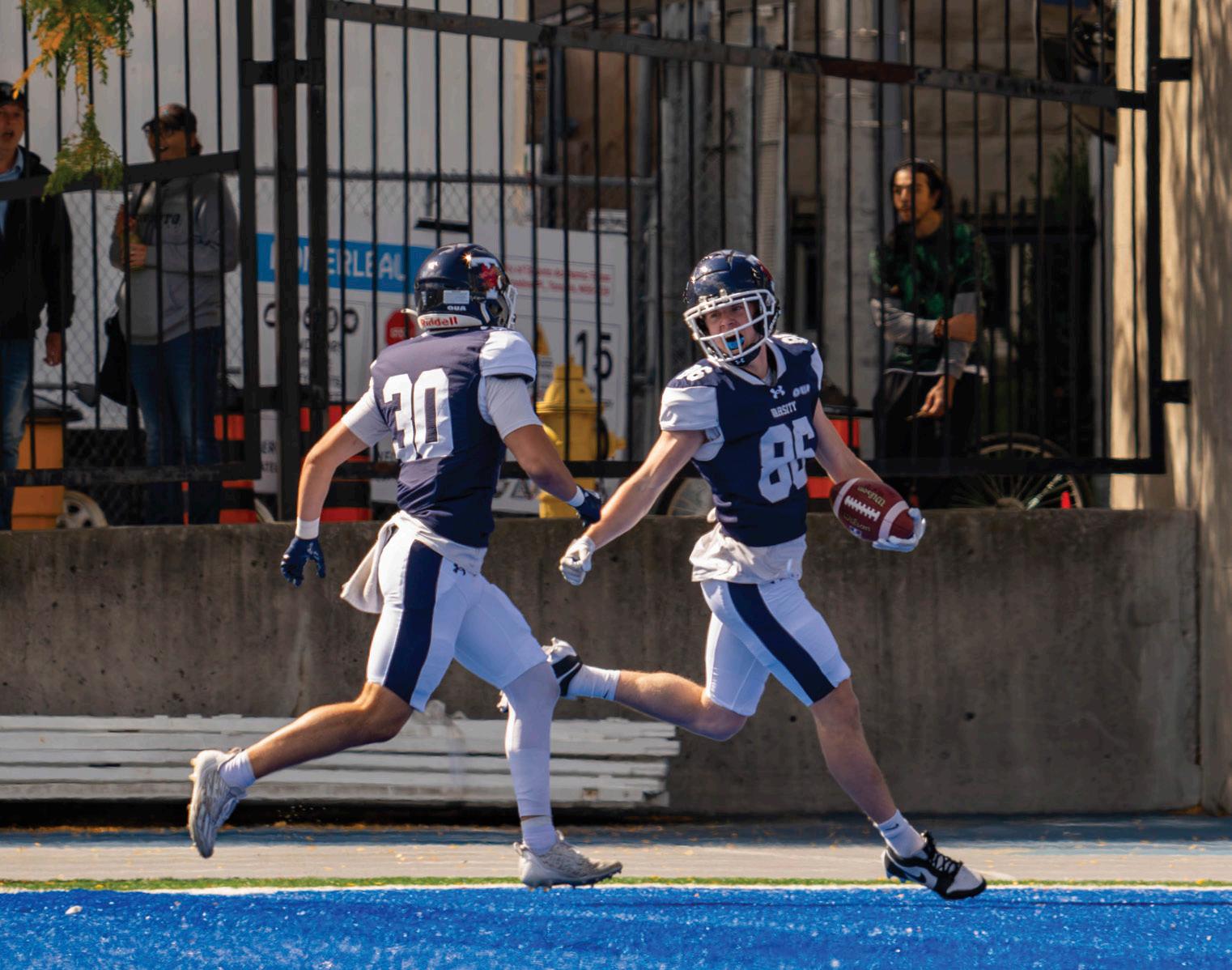
What’s next?
lead. They managed to score another rouge point a few minutes later, bringing the score to 14–31. Finally, with 4:08 minutes remaining, the Lancers scored their last field goal while the Blues went scoreless in the quarter, closing out the game with a
You should join U of T’s Novice Rowing team
What makes the 4:00 am wakeup worth it?
Emily Rosevear Varsity Contributor
While morning routine influencers preach waking at seemingly insane hours to perform meticulously scheduled ice water facials and full-out sprints, I propose waking for a different reason: to get in a boat alongside seven other people who have never rowed before and a coxswain who has never steered, and try not to crash tens of thousands of dollars’ worth of carbon fibre.
This is novice rowing.
What is novice rowing?
The premise of rowing is generally simple: row the boat as fast and hard as you can for 2 kilometres, with some nuance.
Novice rowing, specifically, is open to anyone who has never competed in a rowing race prior to that calendar year and aims to develop athletes for the next year’s varsity team. In novice rowing at U of T, you solely sweep — rowing with one oar — in a coxed boat, with seven other rowers, or more simply, an eight.
The coxswain, or coxie, directs the boat using foot steering attached to a rudder, and calls out commands to motivate or align the crew during the race. The coxie is responsible for the more strategic part of the race, developing a race plan for when to push hard or what aspects of the stroke to focus on at what distances, whereas the rowers are typically told to leave their brains on the dock when the boat launches and just row.
Though the time of day of novice practices varies from year to year — practices are typically in the morning alongside the varsity team’s regular practices. Boats launch from the dock for practice at 5:30 am, but you’re expected to be there by 5:15 am to sweep the dock, bring the oars to the water, and meet with the team and coaches. Early morning practices are routine to catch the calmer morning water and to keep training outside of school hours or jobs.
The early hours beg the question: what would motivate one to even try out in the first place?
Reasons for joining novice rowing
Rowing tends to be a late-entry sport, so many athletes come from quitting other competitive sports once they reach university, no longer having that athletic outlet. Rowers have all kinds of different athletic backgrounds, from gymnastics, soccer, track, and ice hockey.
“I had just quit the sport I had done all my life, rhythmic gymnastics, and rowing seemed like
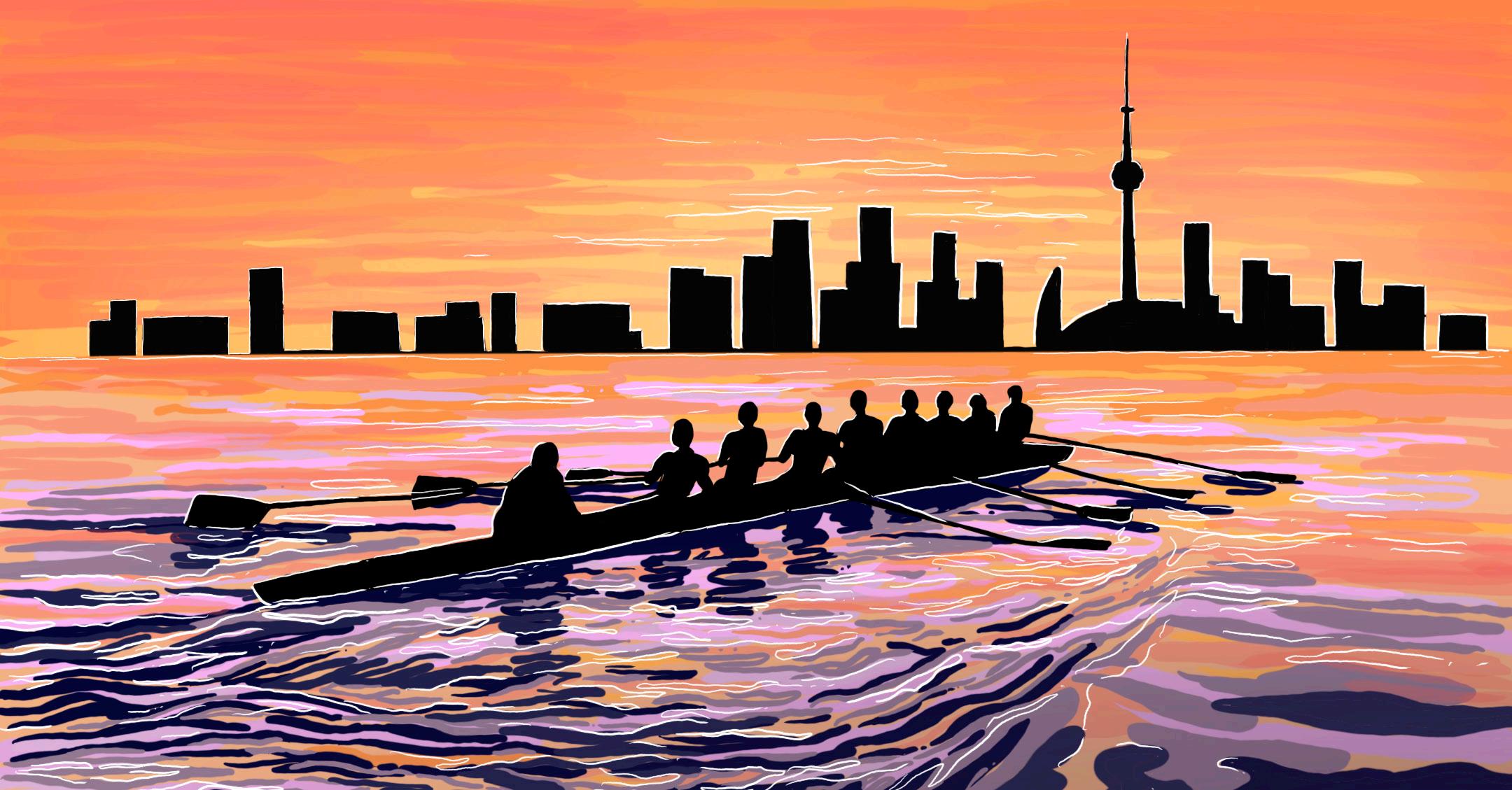
to The Varsity , a member of the 2024–2025 women’s novice team.
Other members of last year’s women’s team, Anastasija Petrovic and Maddy Glowinski, echo Calugar’s sentiment in messages written to The Varsity . “I ran track in high school and was looking for a sport that was just as, if not more, physically demanding; something that would challenge me,” wrote Petrovic. Glowinski wrote that “After a gap year and an 11-year career as a nationally ranked competitive swimmer, I knew I needed something consistent to ground me at such a demanding university.”
However, you can’t forget, “The eventual possibility of wearing team merchandise around campus,” as a motivator, as written in a message to The Varsity by Sami Ahmed, a member of the 2024–2025 men’s novice team and one of this year’s novice coordinators. I think it’s pretty hard to argue against the hold a varsity backpack has on the student body.
Early morning training: Is it worth it?
Despite all the initial motivations, the worst part of novice rowing was consistently and unsurprisingly cited as the early wake-up. Even so, the pros outweighed the cons for every member of the novice teams, and they found other motivations to push them through, such as the gorgeous morning sights or a commitment to self-improvement and fitness. Additionally, they included the team members as a large motivator and one of the best aspects of rowing.
Daniel Pinto, another member of last year’s novice men’s team, explains in a message to
Blues fall to Bold for first loss of the season
The women’s soccer team just falls short despite several close calls
On September 19, the Varsity Blues women’s soccer team faced the TMU Bold in a rematch at the Varsity Stadium. Their previous game earlier in the week on September 14 ended in a 3–3 draw, leading to an intense rematch. While the Blues came out guns ablazing, they ultimately fell short as the Bold edged them out 2–1.
What happened
The Blues opened the game with high energy, playing aggressively and going in for side tackles to win possession. Forward Anne Yeomans fired the first shot within the opening three minutes, setting the tone for a fast-paced first half. Play moved back and forth across the pitch until a stray ball bounced off a car outside the stadium. The next 20 minutes were marked by a flurry of fouls, injuries, and relentless runs from both sides. However, the game took a turn for the
Blues when Bold forward Taylor Fazzari broke through and scored at the 37:15 minute mark, putting the Bold ahead 1–0. Fazzari struck again just before halftime, finishing a precise pass from teammate Telaijah Folkes to double Bold’s lead. The Blues entered the break trailing 2–0.
In the second half, the Blues stayed composed and kept their spirits high as they pushed to get back into the game. Defender Devon Eisen opened the half with a commanding presence, delivering sharp passes and helping control possession. Despite their efforts, the Blues couldn’t break through Bold’s defence — Bold goalkeeper Elisa Paolucci stayed alert, making several key saves and forcing the Blues to sharpen their coordination.
The final minutes of the game were filled with tension, with spectators screaming and cheering. With just four minutes left, the Blues fought back as defender Cassie Chan delivered a sharp pass to defender Hannah Chown, who buried a brilliant goal. Six minutes of stoppage time were added,
The Varsity, “… as I got to know the people on the team more, and we became closer friends, increasingly my motivation was getting the chance to see some of my best friends every single morning. Of course ancillary to that are the great views.”
Additionally, Ahmed explains, “getting to see the sunrise and the city skyline day after day was a motivating factor… It was also a sense of responsibility to my teammates… There were only eight [rowers] on the men’s side and that meant if one of us did not show up, we could not go out onto the water.”
From the novice women’s team, Petrovic concurs, “The best part is the people—you’re all waking up at ungodly hours together, and those shared early mornings forge a strong bond. They’ll be the first to cheer you on.”
Calugar finds both self and team motivations, “my commitment to bettering myself in this sport… is a good motivator… but to a large extent it’s the team and the community it creates… I found that everyone selected for the novice team had bonded pretty quickly as both teammates and friends.”
Moreover, Charlotte Stein, another novice team member, wrote in a message to The Varsity that she also finds the best part of rowing is “the team, it gave me a new group of like-minded people who continually showed up for one another, even during the roughest of trainings,” with Glowinski agreeing, “I’ve met some of my best friends through this program, and that kind of consistent, reliable connection is rare in university.”
I am in no way a morning person, so this time last year, I never could have imagined waking
up at a time when I had gone to bed more than once, but somehow Glowinski is right; the pros always seem to outweigh the cons. The rigidity of my schedule provides structure that I would otherwise be lost without, the physical activity creates a sense of accomplishment and a rush of endorphins, and the community is home to some of the closest relationships I’ve found at U of T. So even though I don’t think I’ll ever manage to be a morning person, I don’t think I could ever forgo waking up at 4:00 am.
Shared goals on the water Glowinski sums up the novice women’s crew’s year almost perfectly, “This year, our novice women’s crew had one of the most successful seasons in years for UofT because we all shared the same mindset: we were willing to hurt for each other, push through together, and do whatever it took to win. Rowing demands a kind of pain you can’t fully put into words if you want to succeed — but you’ll gladly take it on for the people in your boat. Those people will become some of the strongest, most inspiring humans you’ll ever meet.”
This year’s novice tryouts have just finished, having occurred in the first weeks of September, and though their practices are in the evening and do not require waking up at 4:00 am, I trust the team will find every reason we did to come back next fall for the early morning varsity team practices.
Emily Rosevear was a member of the 2024–2025 Women’s Novice Rowing Team, and is currently a member of the Varsity Women’s Rowing Team.
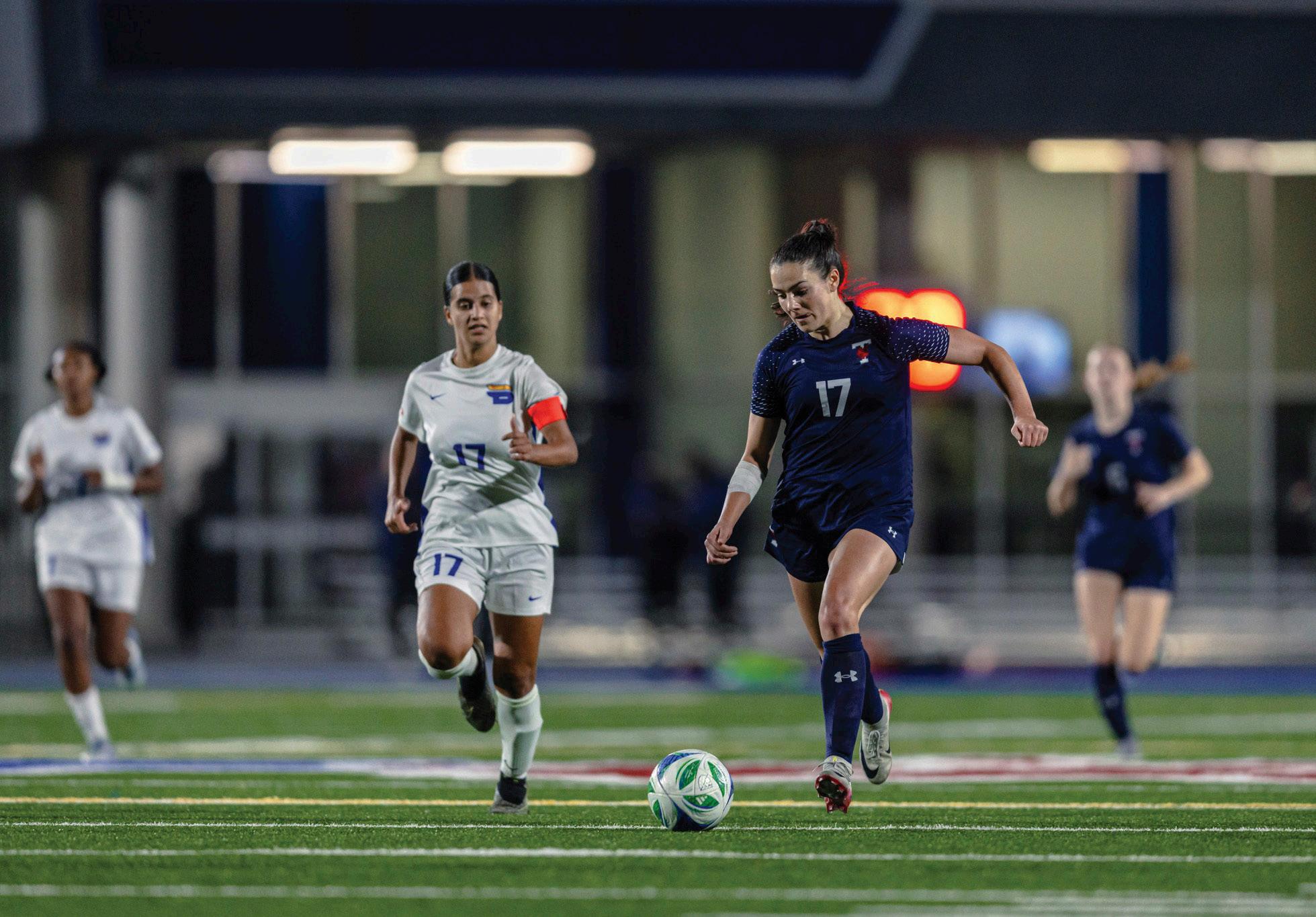
1. Element whose symbol is its first letter
2. Lump in your throat?
3. Arrives at JFK Airport, say
4. Hindu deity often depicted with blue skin
5. Lip-______
6. Nike logo
7. Bottomless brunch cocktails
8. October birthstone
9. ______ Z
10. Predator whose name literally means “biting fish”
11. Critical hospital areas: Abbr.
12. Fast time?
13. What a circle lacks
21. “Yee-______!”
22. “______ better to have loved and lost than never to have loved at all”
25. Quarrel (with)
27. Opposite of WSW
28. ______ Gala
29. Bali, Bora Bora, et cetera
30. Actress Perlman of Cheers
31. Starry-______
32. Nanny : kid :: ewe : ______
33. Cookies and cream cookie
34. Sleeping bag, portable stove, and flashlight for one going camping
39. Columns’ counterpart
40. Face on the US penny, familiarly
42. Thanksgiving serving
45. Bamboozled
47. Put someone on a pedestal
49. Emma, in Emma
51. Formula ______
52. The ______ Show (1998 movie about a man whose entire life is a reality TV show)
53. Rage
57. Red dye used in cosmetics
58. Arises (from)
59. A crowd?
60. There’s one in tihs clue
61. Word with guard or safety
62. __ ____ of Green Gables
63. Soft cheese on a charcuterie board
64. Based on established conventions: Abbr.
66. Classic diner sandwich

Tying the knot

ACROSS
1. Eats a calorie surplus, say
6. Urban air pollution
10. Heap
14. Female organ that produces eggs
15. Clean (off)
16. ______ coffee
17. Altercation
18. Oldest independent state in the Arab world
19. Step on a ladder
20. Like one who still uses a typewriter
22. Sample
23. Crosby, Stills, ______ & Young
24. Nincompoop
25. Envy, wrath, e.g.
26. US state whose official motto is “Live Free or Die”
32. Wolverine’s alias
35. Red, black, yellow, e.g.
36. Grey, in a way
37. “______ we there yet?”
38. The Jazz Age, for one
ACROSS
1. What can you do this weekend? (Check the title)
16. What’s happening at 21 Sussex Ave this weekend? (It’s in the title)
44. Have some time from 11AM–3PM Saturday and Sunday? (There’s the same number of blank spaces as the previous clues)
79. What should I do with my empty resume?
98. I feel like you get the idea?
41. Have a 22-across
43. Author Harper of To Kill a Mockingbird
44. It may be smoked or cured
46. ______-Wan Kenobi
48. In first place
50. Risky thing to be living on
54. ______ and outs
55. Hockey player Bobby of the Boston Bruins
56. Respite
60. Hint
63. Wireless technology named after 10th-century King of Denmark and Norway
65. Jerk
66. Filled to the ______
67. Early ______
68. Stereotypical air freshener shape
69. Actress Minnelli of Cabaret
70. You can watch it on Crunchyroll
71. Feature of Nintendo Switch model released in 2021, for short
72. Many a prom attendee
73. Like black holes and pound cakes
